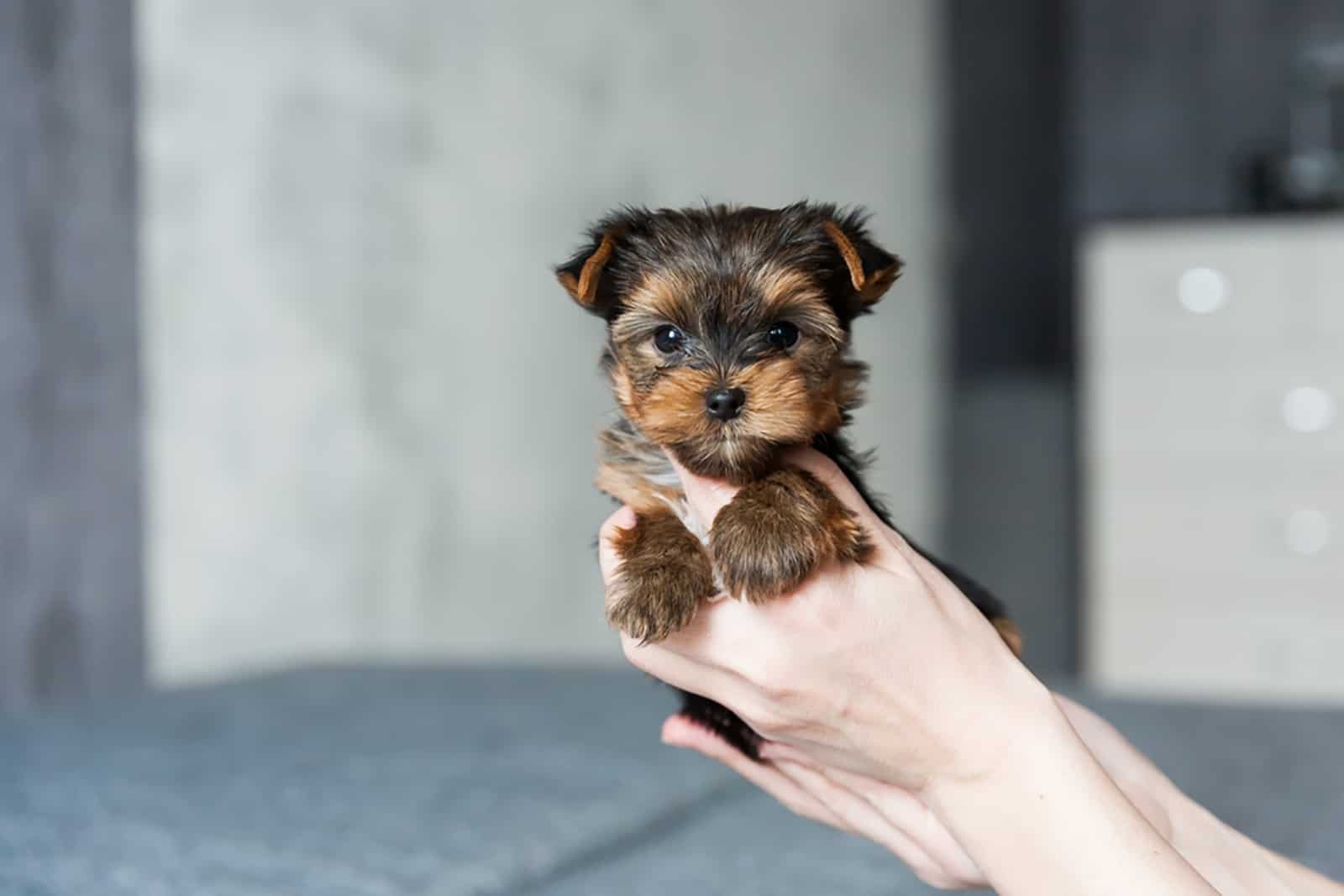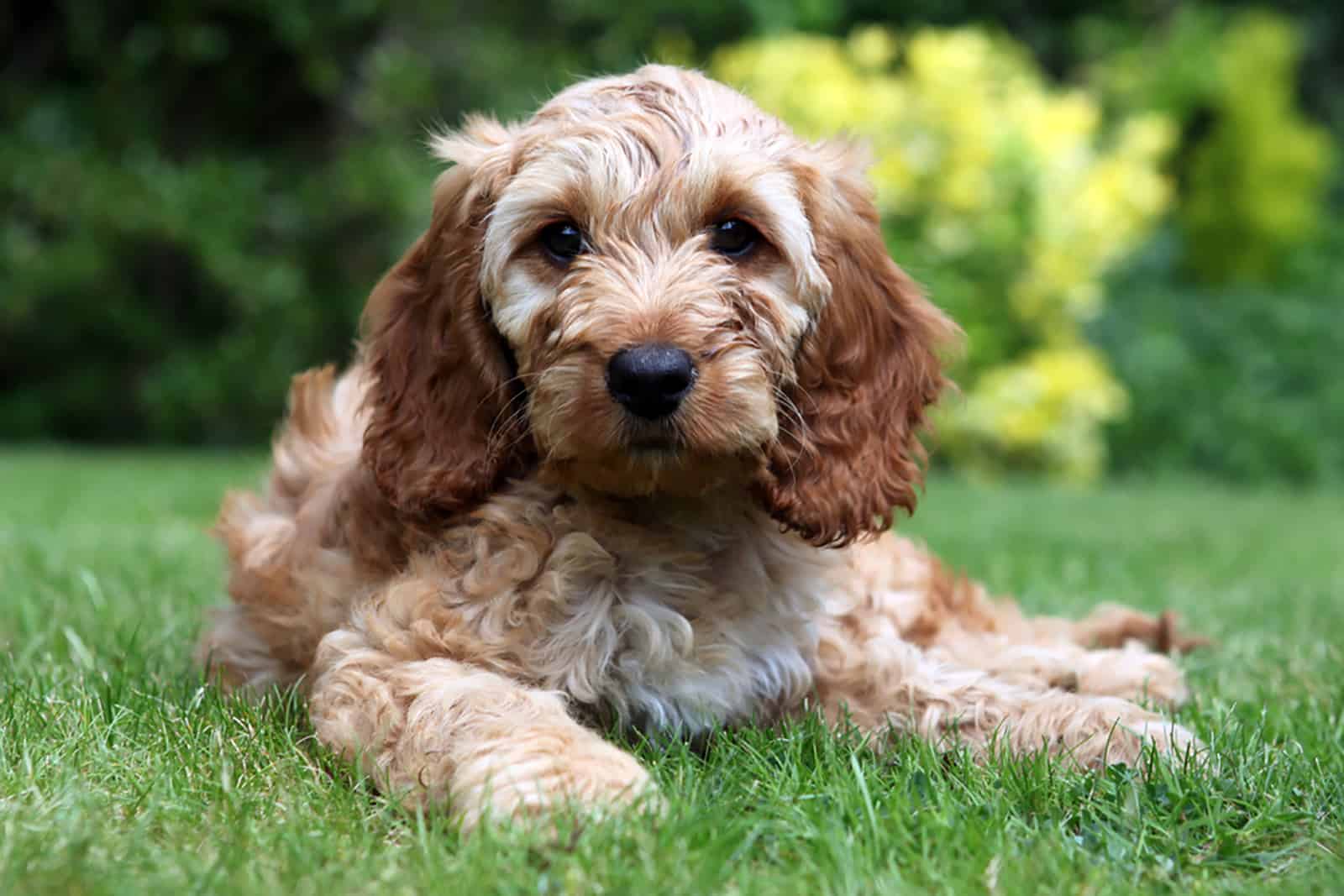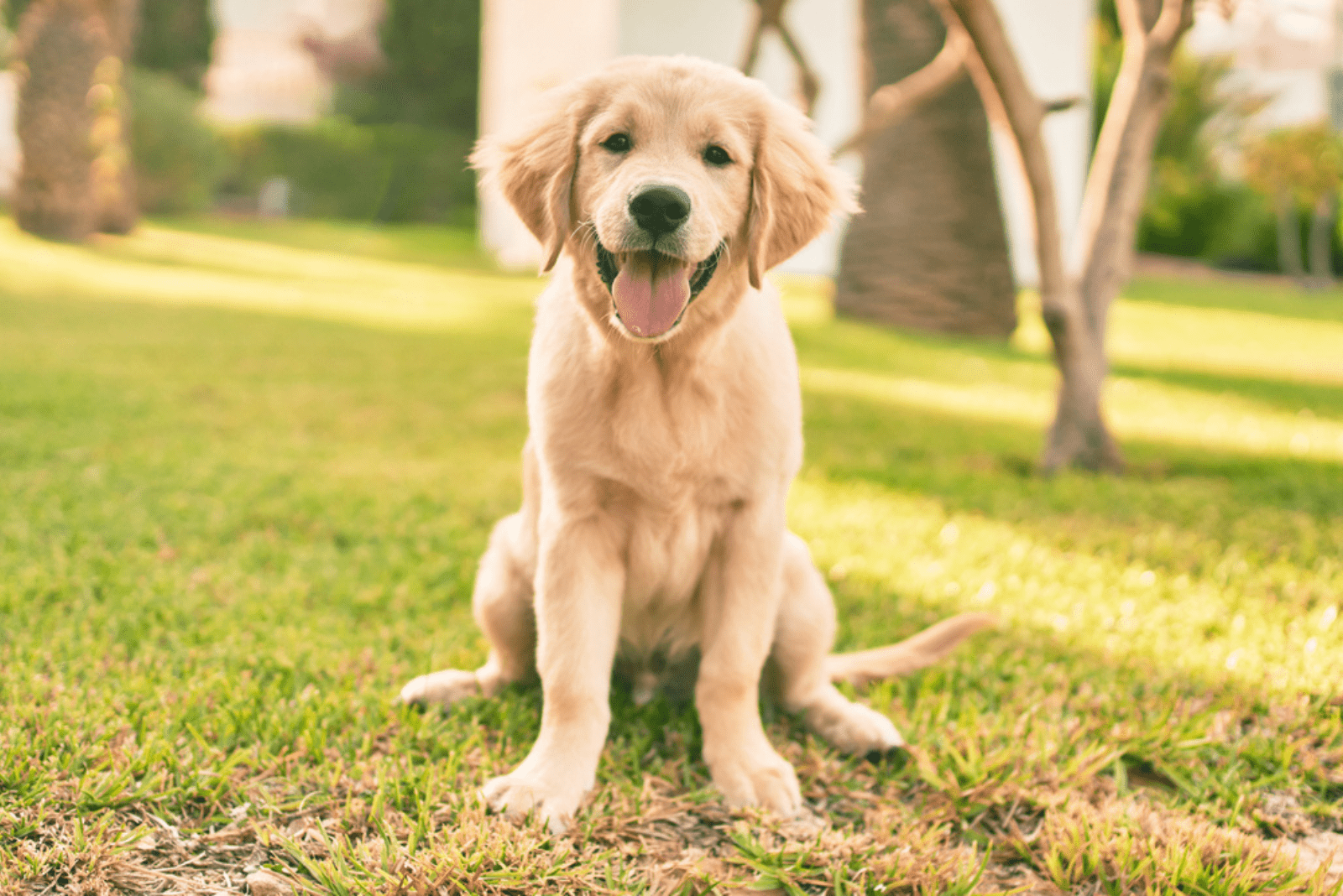Guten Tag! Today, we have prepared a list of 45 German dog breeds – yes, those dogs with hard-to-pronounce names. But, don’t worry. By the end of this article, you might as well become fluent in German!
We figured that it would be best to say a few useful things about each German dog breed. For instance, we are going to mention each dog’s breeding purpose, characteristics, lifespan, and the good and the bad sides (if there are any bad sides!).
German dog breeds are extremely popular across the whole world. In fact, some of these German dog breeds are more popular in the U.S. than they are in Germany.
If you are interested in popular dog breeds from Germany, then buckle up!
We are going to take you into the heart of Europe and show you some of the most amazing German dog breeds!
1. Standard Dachshund
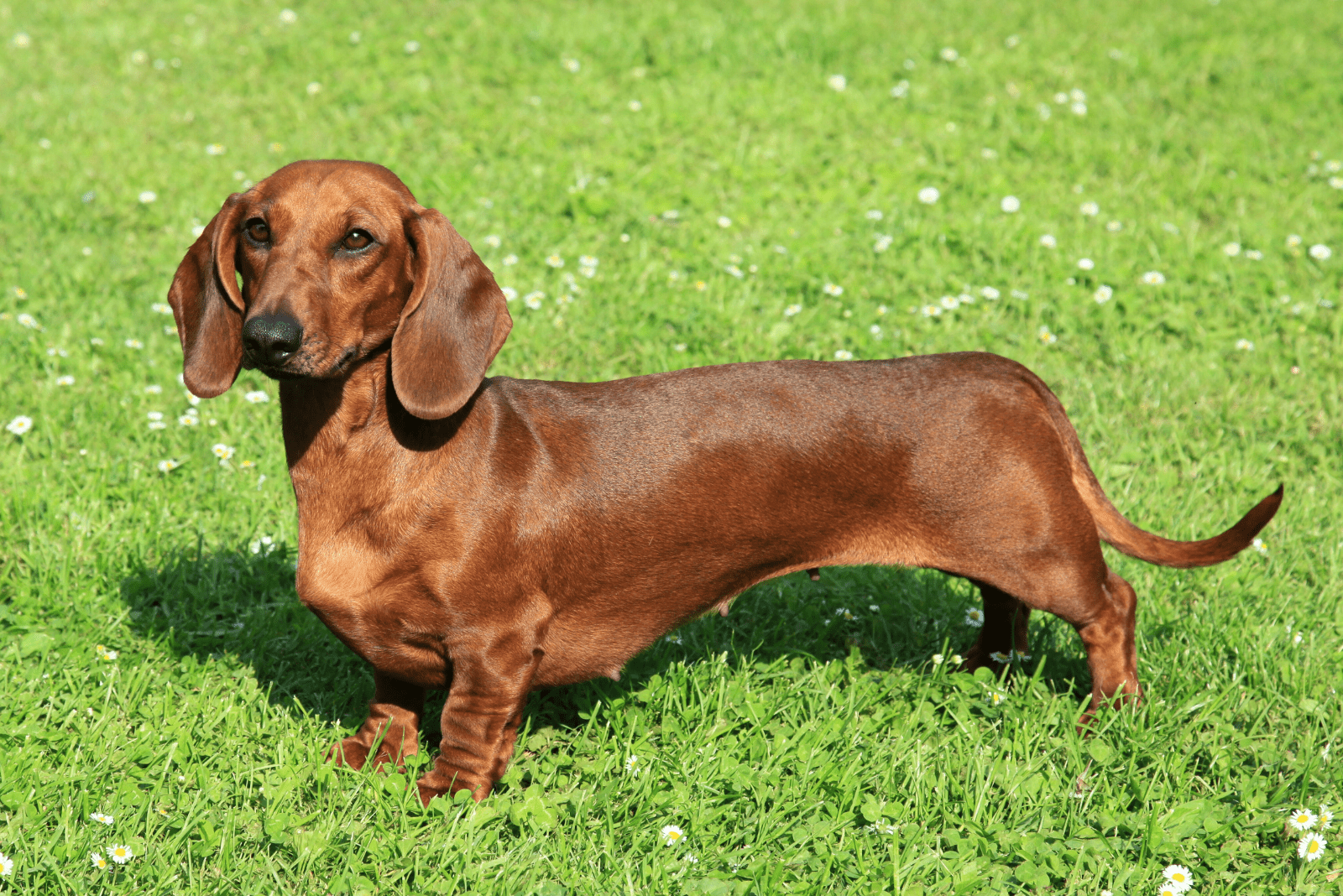
Let’s talk about everyone’s favorite sausage dog — the standard Dachshund. But, before we do that, let’s pronounce the word right. Dachshund is pronounced like “dax-hound” and what it actually means is badger dog (Dach meaning badger, and Hund meaning dog).
Alright, the first German language lesson is over. Now, it’s time to introduce this lovely German dog breed.
History
Back in the 15th century, the appearance of an interesting sausage-looking dog shook every German citizen. It took until the 17th century for the Dachshund breed to develop the same characteristics we see today.
Believe it or not – what led to the development of the Dachshund dog breed was the increase of the rabbit and badger population in Germany.
Appearance
According to the American Kennel Club, the standard Dachshund is a small dog that weighs between 16 and 32 pounds. The Dachshund is a canine shorty, reaching up to nine inches in height.
The standard Dachshund is known to inherit different types of coats. We’re talking about smooth, long, and wire-haired Doxies.
While we’re talking about a Dachshund’s coat, we should mention Dachshund colors that come in many shades and hues, with black and tan being the most common.
Temperament
Dachshunds are very interactive and intelligent dogs. Most standard Dachshund owners that I met say that Dachshunds are needy and they require lots of attention throughout the day.
In fact, if they are left alone for too long, Dachshunds bark intensively and even become destructive. When they are properly cared for, Dachshunds make amazing little companions.
2. Miniature Dachshund
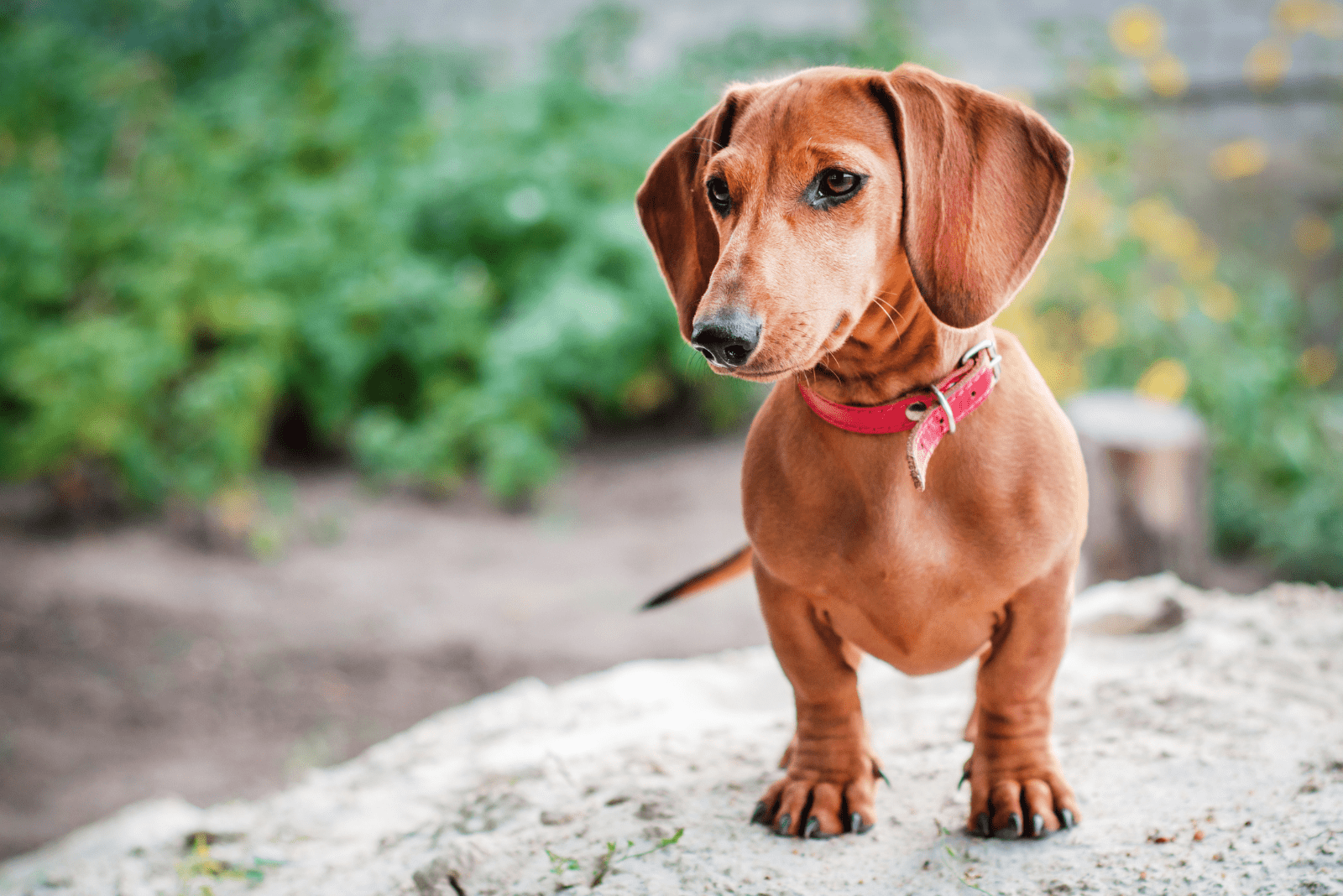
Now that we have said a thing or two about the standard Dachshund, let us introduce you to its miniature version.
History
Unlike its standard counterpart, the miniature Dachshund has been bred to hunt rabbits that are smaller than badgers, and that made smaller dens. Their high prey drive is what made people link Dachshunds to aggression.
Miniature Dachshunds appeared after standard Dachshunds, back in the 17th century. It is said that mini Dachshunds derive from breeding the smallest standard Dachshunds (which is understandable).
Appearance
Miniature Dachshunds are really mini — weighing up to a maximum of 11 pounds, and reaching heights of a whopping six inches! Just like in other dog breeds, there are differences in size between male and female Dachshunds.
Mini Dachshunds are small sausage dogs covered in either smooth, wire, or long hair. Depending on the season and hair type, a Dachshund’s shedding can be either moderate or low.
Although most people find the standard Dachshund’s appearance cute, there are some health issues associated with the Dachshund’s growth. Health issues like intervertebral disc disease and hip dysplasia may shorten a Dachshund’s life expectancy.
Temperament
Miniature Doxies hate being alone, and owners often Tweet about what it’s like living with a Dachshund. If this doesn’t say a lot about their funky personality, then I don’t know what else will!
Just like standard Dachshunds, miniature Dachshunds tend to get needy and might develop separation anxiety. Separation anxiety is usually the cause of why Dachshunds shake often.
3. Great Dane
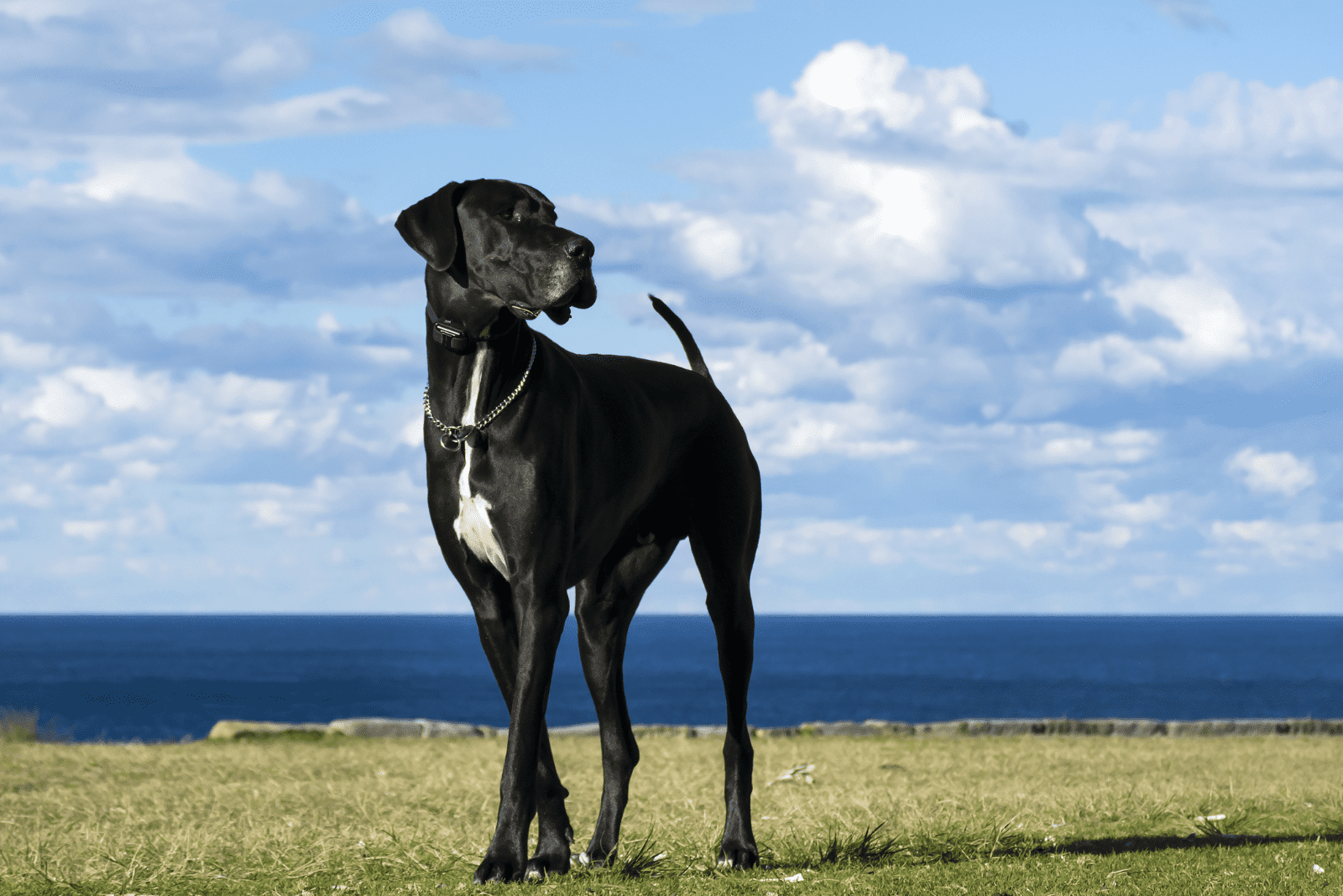
Also known as gentle giants, Great Danes are among the most popular dog breeds in the U.S. Despite their large size, Great Danes are big babies that love to cuddle and express their goofy side.
History
Great Danes were developed back in the late 1800s. You might call the Great Dane an ancient breed as it derives from Mastiff-type dogs. Primarily used as hunting dogs, Great Danes were incredible at hunting bigger animals, such as wild boars.
There is also information that Great Danes were used as military dogs during world wars.
Appearance
A Great Dane’s growth is the first thing we think about when someone mentions this large dog. Weighing up to 180 pounds and reaching up to 36 inches at the withers, the Great Dane is the tallest dog in the canine world.
However, because of its fast growth rate, there are many developmental health problems that can occur, making the Great Dane’s lifespan pretty short.
Besides its massive growth, the Great Dane comes in a variety of colors that make it stand out among the crowd. Its coat is short and it sheds moderately.
Temperament
Because of their loving temperament, a Great Dane makes great mixes that inherit the kind nature of the gentle giant.
We are talking about a very calm dog breed. However, a Great Dane may manifest a huge change in its behavior if it has a congenital or inherited disorder of the nervous system. So, make sure to choose a reputable Great Dane breeder!
4. The German Shepherd
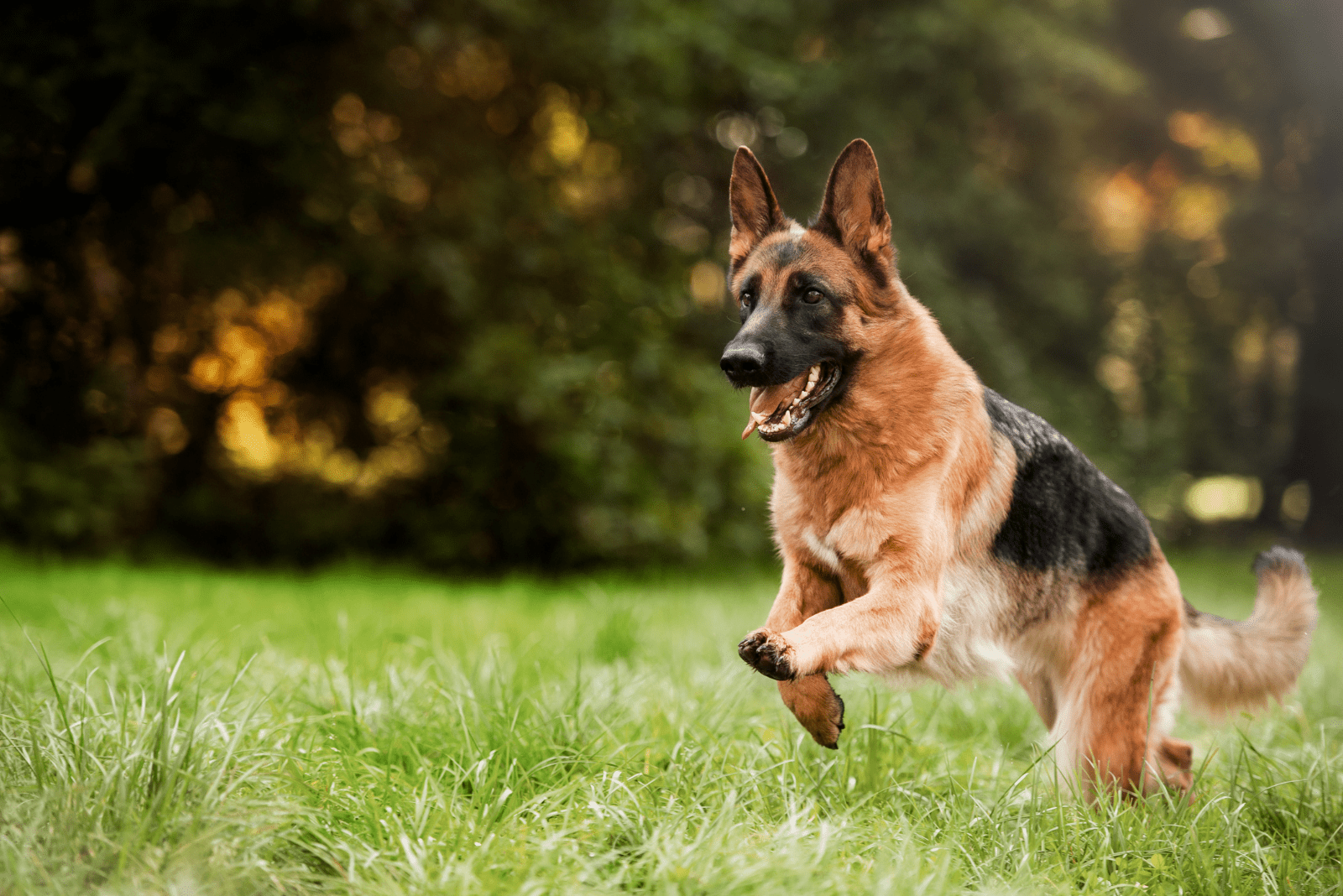
The German Shepherd is that pup that no one can get bored with. It’s an extremely popular dog breed everywhere in the world.
History
The German Shepherd dog originates from the late 1800s. In fact, the man behind the development of the German Shepherd was Max von Stephanitz.
What he did was combine various German herding dogs that resulted in a wonderful German Shepherd pup. That being said, a GSD’s purpose was to herd livestock.
German Shepherds first appeared in the U.S. back in 1907 when they were used as military dogs and search and rescue dogs.
Appearance
According to the German Shepherd growth chart, this large dog can grow up to 26 inches in height, and its weight rises up to 88 pounds.
From standard black and tan to remarkable white to beautiful liver German Shepherds — there are a lot of colors to choose from!
Due to its large size, the GSD isn’t considered a very healthy dog breed. GSDs are very prone to dog bloat. To make sure you get a healthy German Shepherd puppy, make sure to find the best German Shepherd breeders.
Temperament
German Shepherd dogs are not only used as service dogs. These loving dogs are all-time favorite family dogs of American folk.
Due to their affectionate, yet protective personalities, breeders could not resist developing different German Shepherd mixes.
5. Doberman Pinscher
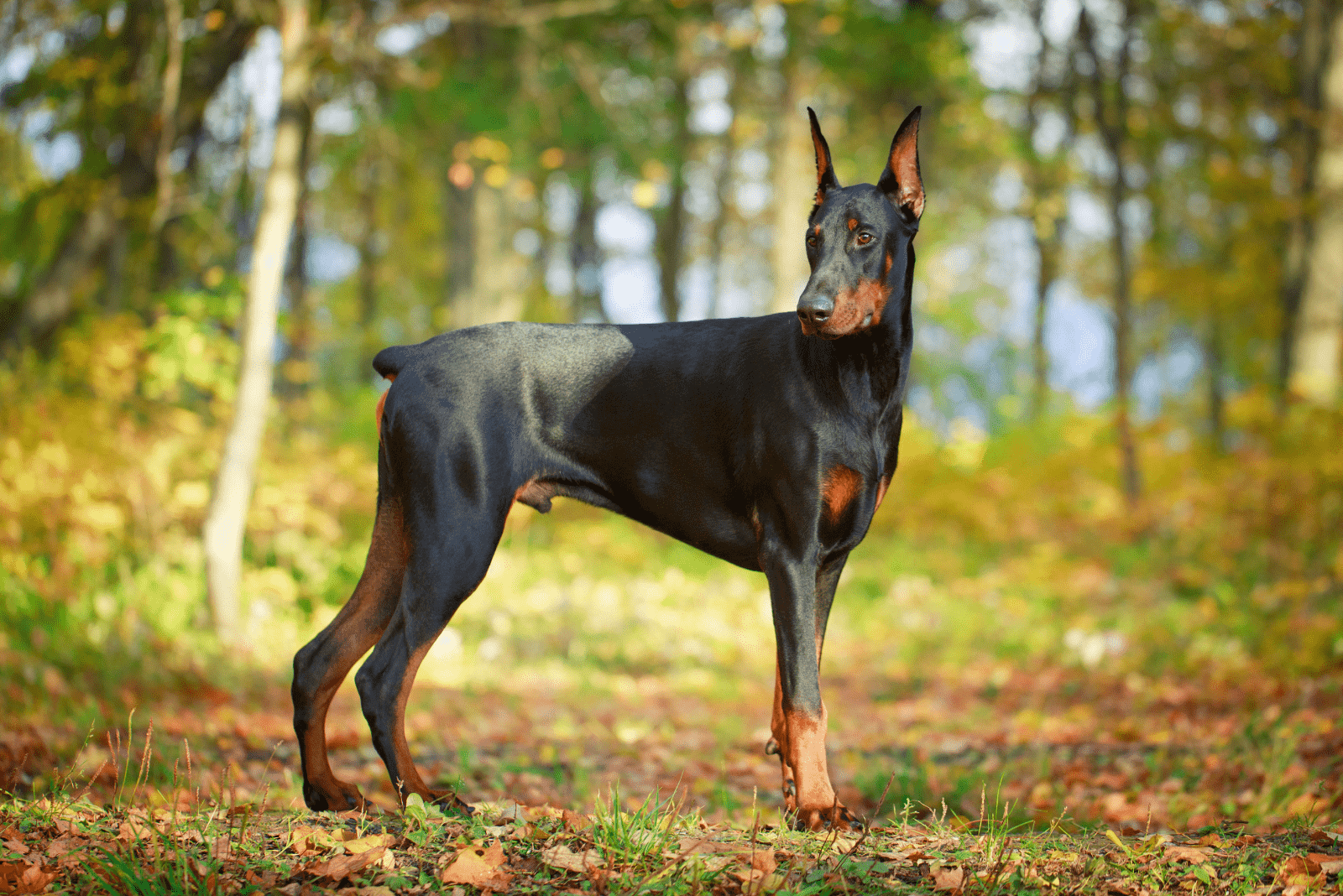
Here’s another incredible and ridiculously popular German dog breed. You have probably heard about the Doberman Pinscher, but did you know that its history is as interesting as its appearance?
History
The creator of the Doberman Pinscher dog breed is no other than the famous German tax collector, Karl Friedrich Louis Dobermann. Back in the 1880s when tax collecting was still a big thing, Louis needed a fierce bodyguard.
As he already owned a dog pound, Louis figured it would be best to mix a bunch of excellent dog breeds like Rottweilers and German Pinschers to see what result he would get. And so, the Doberman Pinscher was born.
Appearance
Dobies are medium dogs that might appear intimidating with their deep chest and muscular body. Doberman Pinschers grow between 75 and 88 pounds. There are size differences between male and female Doberman Pinschers.
Although a Doberman’s uncropped ears are cute as heck, some dog owners decide to crop their Dobie’s ears. This usually adds to the overall intimidating looks.
We all know these pups as black and rust-colored dogs, but the Doberman Pinscher’s colors are very versatile. Their short coat is easy to groom, but it can shed moderately.
Temperament
Considering the Doberman Pinscher’s development, this dog was made to protect its human pack, so it is safe to say that Dobermans make great watchdogs and guard dogs.
But, they’re not all so serious. Doberman Pinschers are also known as goofy and outgoing. They are very active dogs that love outdoor activities.
6. Boxer
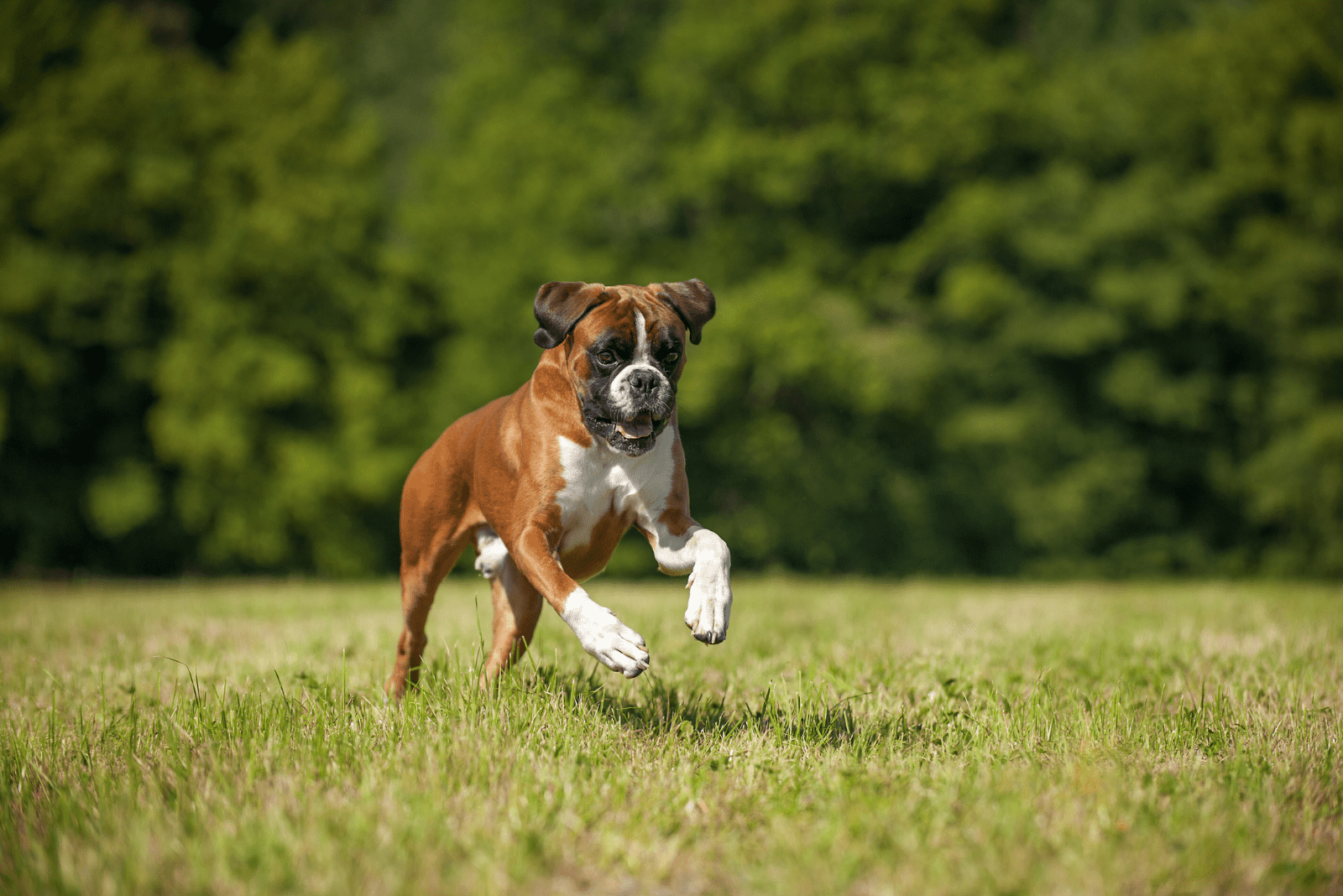
Oh, Boxers – our beloved goofballs with heaps of energy. It’s no wonder why this German dog breed became popular across the whole world.
History
The Boxer was bred for various activities such as bull baiting, livestock herding, and simply keeping fellow humans company.
As time went by, the Boxer developed its characteristic looks that we know today. Even though there are European and American Boxers, both are the same dog breed — the only thing that’s different is the kennel club’s breed standards.
Appearance
As far as appearance goes, both male and female Boxers inherit a brachycephalic muzzle and a medium-sized body. And, because of their short muzzle, Boxers are prone to breathing issues, such as Brachycephalic Obstructive Airway Syndrome (BOAS).
With males being bigger than females, Boxers grow up to 24 inches in height. Their bodies are sturdy, yet elegant. Boxers are known for their wide and deep chest that is often colored with white markings. Boxer colors come in various shades and hues, making this pooch very unique-looking.
Temperament
Boxers are wholehearted, clumsy, and affectionate jokesters that love all the attention they can get. As loving as they are, Boxers are great with all family members.
Boxer puppies are very energetic, but they do get easier as time goes by. Besides wonderful purebred Boxers, Boxer mixes also make incredible companion dogs.
7. Stichelhaar
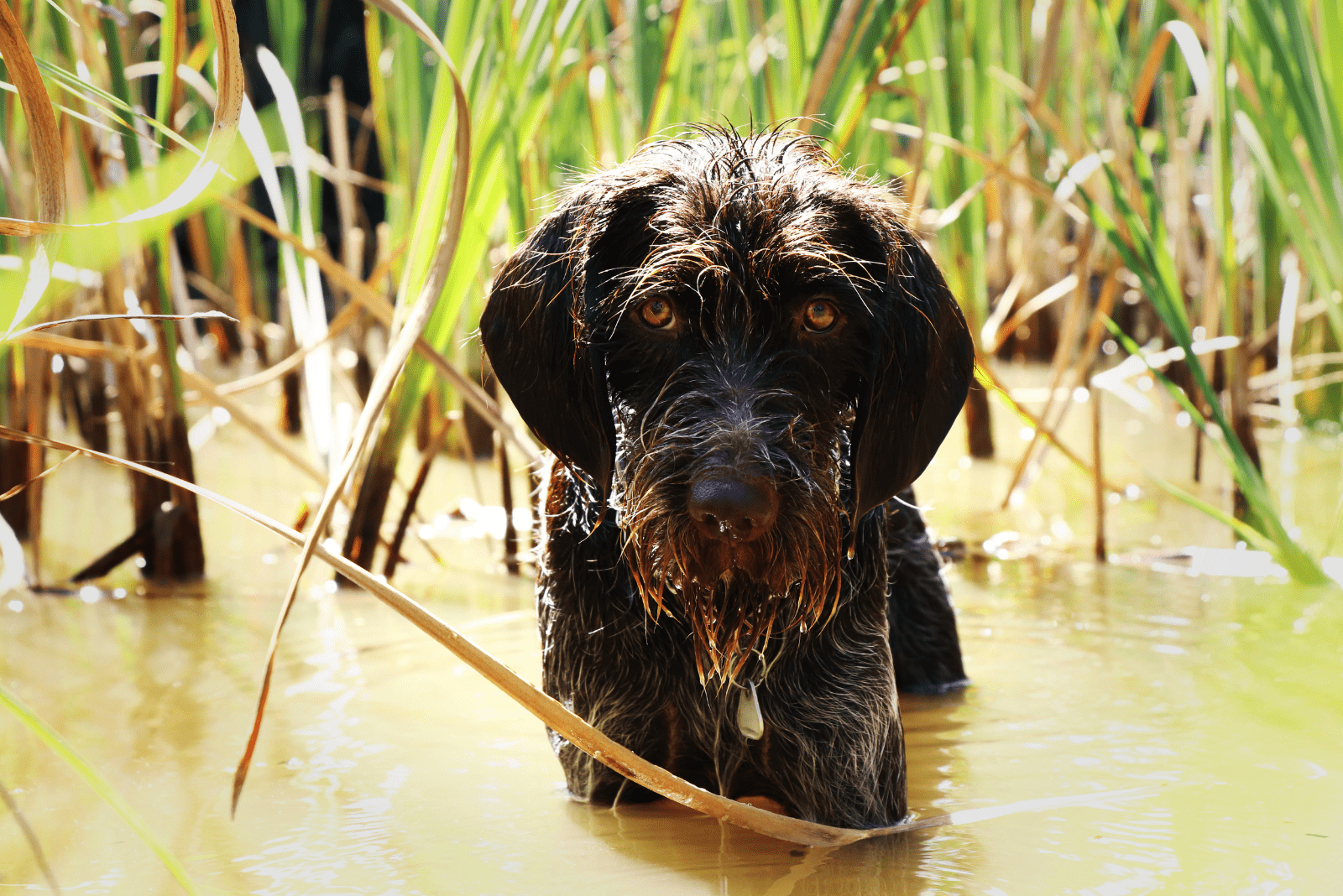
The Stichelhaar (in other words, the German Rough-haired Pointer) is truly a unique German dog breed. As its name implies, the German Rough-haired Pointer is a pointing dog with rough hair!
History
The Stichelhaar’s development dates back to the late 19th century. The Stichelhaar’s breed standardization went through many ups and downs, but by the end of the 20th century, this German dog breed was officially recognized.
However, the German Rough-haired Pointer is very rare, and it is usually only seen within German borders. This pooch isn’t on the popular side in the U.S.
Appearance
The Stichelhaar is a medium-sized dog with an interesting rough coat that ranges from brown, gray, or white, to tri-color. According to the FCI Stichelhaar breed standards, this pointing dog grows up to 28 inches in height.
The Stichelhaar inherits floppy ears that fold downwards, making this dog prone to ear infections. Most Stichelhaar dog owners opt for ear plucking in order to maintain good hygiene.
Temperament
As a hunting dog, the Stichelhaar is very energetic and alert. It loves to run around, and digging holes seems to be its favorite hobby.
Besides its need for various activities, the Stichelhaar is a calm dog with a loving personality.
8. German Shorthaired Pointer
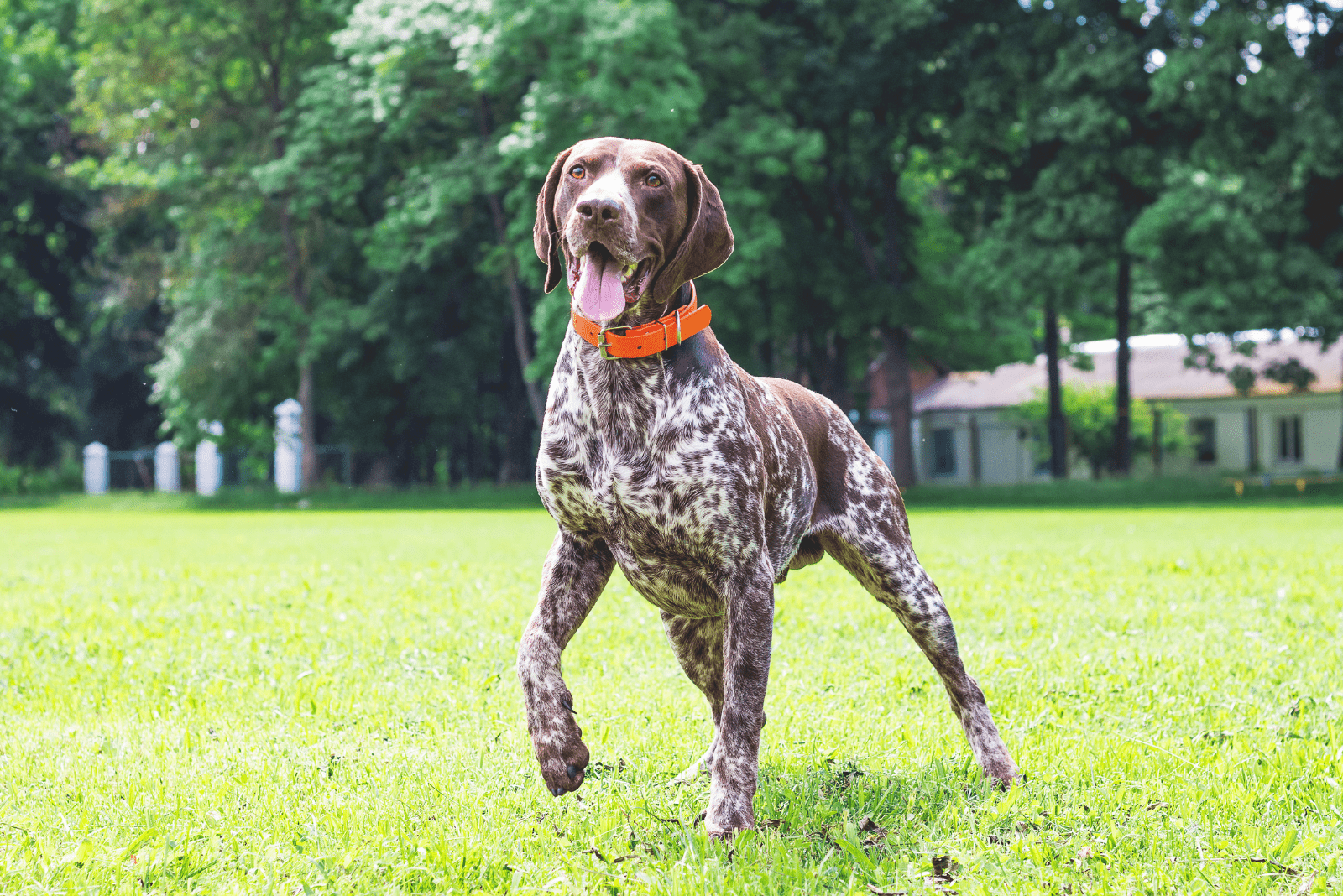
Meet the German Shorthaired Pointer – a German dog breed that inherits a distinct act of pointing. When I first saw this breed, I immediately fell in love with it!
History
It is said that the first GSP appeared in the late 17th century in Germany. Its development was the result of crossing German bird dogs and Spanish pointers.
Their personalities and incredible hunting skills gave birth to a loving dog we know today as the German Shorthaired Pointer.
Appearance
The German Shorthaired Pointer growth chart describes this sporting dog as a medium to large breed. Its size makes the GSP prone to health conditions, such as canine hip dysplasia.
The German Shorthaired Pointer belongs to the spotted dog breeds. Paw lovers who have never seen a GSP in real life often mistake it for a Dalmatian! GSPs range from roan, gray, liver, or white, to black.
Temperament
Not only is the German Shorthaired Pointer an agile hunter, but it is also a loving family dog. Both male and female German Shorthaired Pointers inherit a sweet nature and a willingness to play.
They are great travel buddies, and will love to follow you wherever you go!
9. German Spitz

Sassy and classy — meet the German Spitz. This small dog is so fluffy that you will want to give it a big hug!
History
The German Spitz’s history is linked to the middle ages. The closest cousin breed to the German Spitz is the Samoyed. So, it is said that the German Spitz originates from such herding dogs from the North.
Basically, the Vikings brought their herding dogs to Germany at some point, and the Spitz-type dogs were developed.
Appearance
Double coated and ultra fluffy — the German Spitz is known for its fuzzy, curled up tail and its small, upward-pointed ears.
Belonging to the small-dog group, the German Spitz reaches 11 inches in height. Just like most small dogs, the German Spitz is a long-living pooch, with an average lifespan of 14 to 16 years.
Temperament
Even though it’s a small dog, the German Spitz barks very loudly. This can be a great personality trait of a watchdog, but when your dog barks at nothing, it can become very annoying.
With proper socialization and training, the German Spitz will make a great companion dog that will make each day a new adventure.
10. Rottweiler
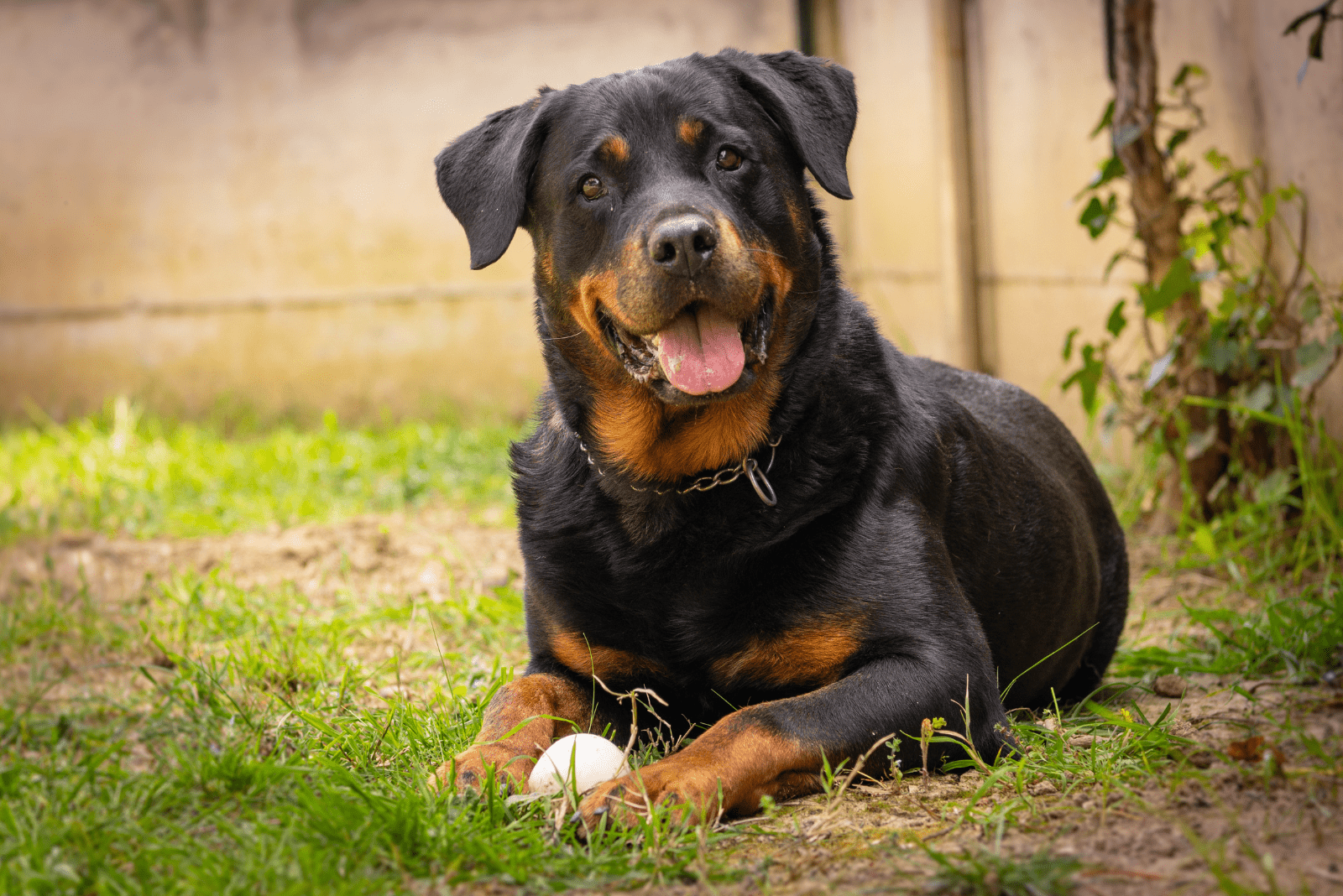
Rotties are America’s favorite dogs for sure. I have seen many Rottie owners who are completely crazy about their pups! And, what I also noticed is that you can never have only one Rottie!
History
The Rottweiler dog breed originates from a small German town called Rottweil. However, early Rottweiler history states that this dog descends from Roman Mastiff-type dogs that were brought to Germany.
Rottweilers have been used for various jobs — from cattle herding to military work.
Appearance
Easily recognized by their black and tan coat color, large and blocky head, as well as muscular, medium to large body, Rottweilers are always in the center of attention.
A Rottweiler‘s growth is so rapid that they may be prone to a health issue called Cruciate Ligament Rupture.
Rotties usually appear in a short, double coat that is straight. But, there are also long-haired Rottweilers that inherit beautiful locks.
Temperament
Everyone knows that Rotties are amazing family dogs that are devoted to their owner. Besides these family-oriented traits, most of us are aware that Rottweilers can become aggressive.
Aggression signs in Rottweilers are more exposed than in any other breed, and it usually comes to this when Rotties are neglected by their owner.
11. Miniature Schnauzer

Did you know what the name “Schnauzer” translates to?
Schnauzer literally means ‘snouter’! And, this little snouter dog is everything you ever wanted.
History
Mini Schnauzers first appeared during the late 19th century. German breeders invented the Mini Schnauzer by crossing a standard Schnauzer with a smaller German breed like the Affenpinscher or the Miniature Poodle.
Its purpose was to drive livestock, and guard households and owners. The Mini Schnauzer was also useful in the police and in the military.
Appearance
Being named after its remarkable mustache, the Miniature Schnauzer’s appearance reminds us of an old and wise wizard!
Miniature Schnauzers are small dogs that are known for their banded hairs (one strand of hair is colored in three shades). One of the features that make Mini Schnauzers special is their hypoallergenic coat.
These physical characteristics can only be developed by reputable Miniature Schnauzer breeders who put a lot of effort into quality breeding programs.
Temperament
The Miniature Schnauzer is beyond intelligent! This small dog is extremely smart, with lots of energy on its paws. That being said, it is a must to ensure this pup gets enough physical and mental activity.
12. Standard Schnauzer
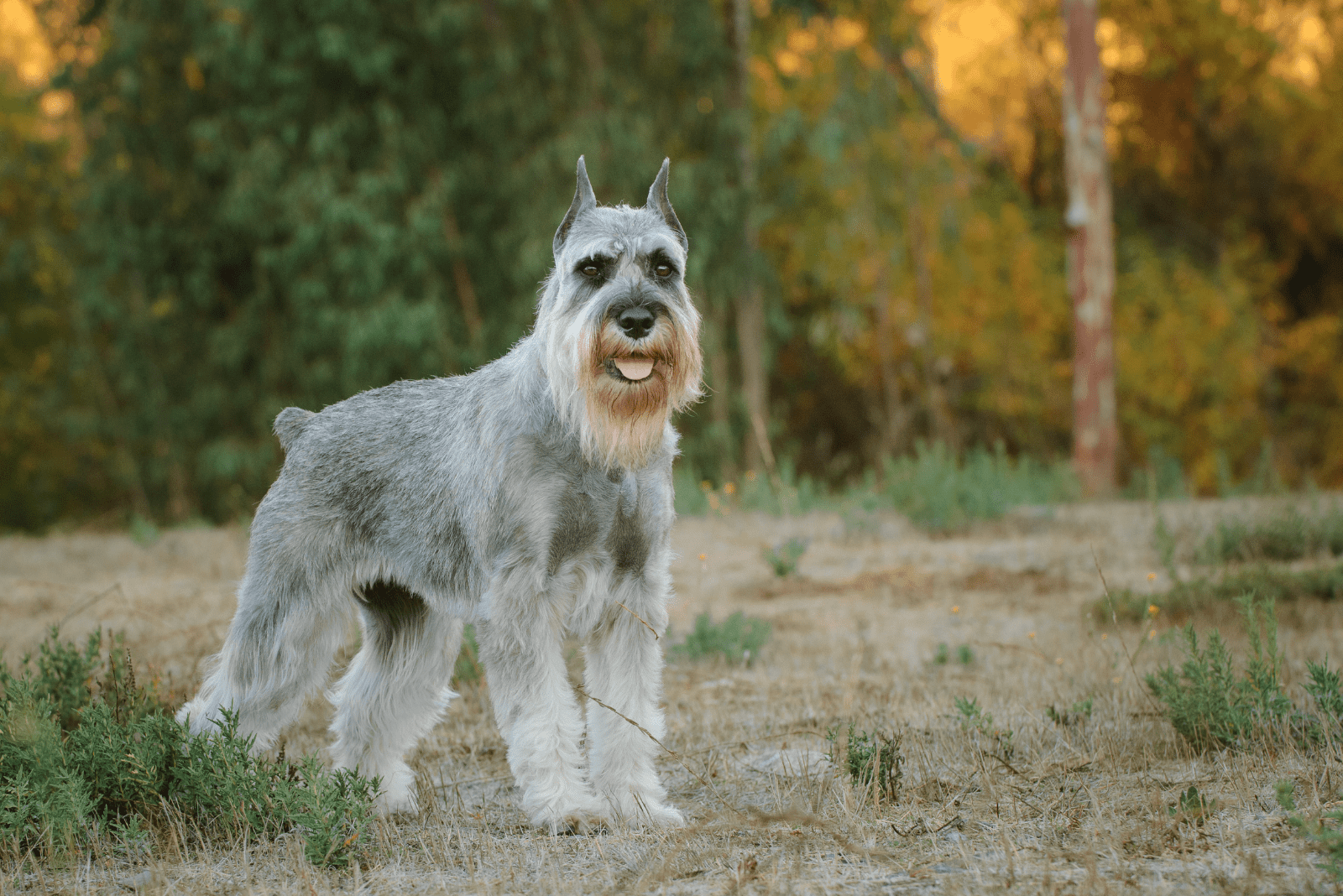
Who came first, the Mini or the Standard Schnauzer? The correct answer is the Standard Schnauzer. This dog breed is guilty of creating both the Miniature and the Giant Schnauzer breed.
History
It is believed that the Standard Schnauzer was developed by crossing a wirehaired German Pinscher with a black Poodle and a gray Keeshond.
The Standard Schnauzer has proven itself to be a great military dog that was used in all sorts of work — especially during the war.
Appearance
The Standard Schnauzer is medium in size, weighing up to 45 pounds. Although most Standard Schnauzers stay within their normal weight scale, some may be prone to canine obesity, and can weigh more.
Standard Schnauzers inherit a wiry double coat that requires frequent grooming. Most of their torso is short-coated, but their legs and abdomen are covered in long, banded hairs.
Temperament
Loyal, fun-loving, and alert — that’s the Standard Schnauzer for you. As an agile working dog, the Standard Schnauzer loves having a job to do whether it involves running or cuddling.
These dogs do well in all kinds of settings, but they are the happiest with a spacious garden in which they can play and run.
13. Giant Schnauzer
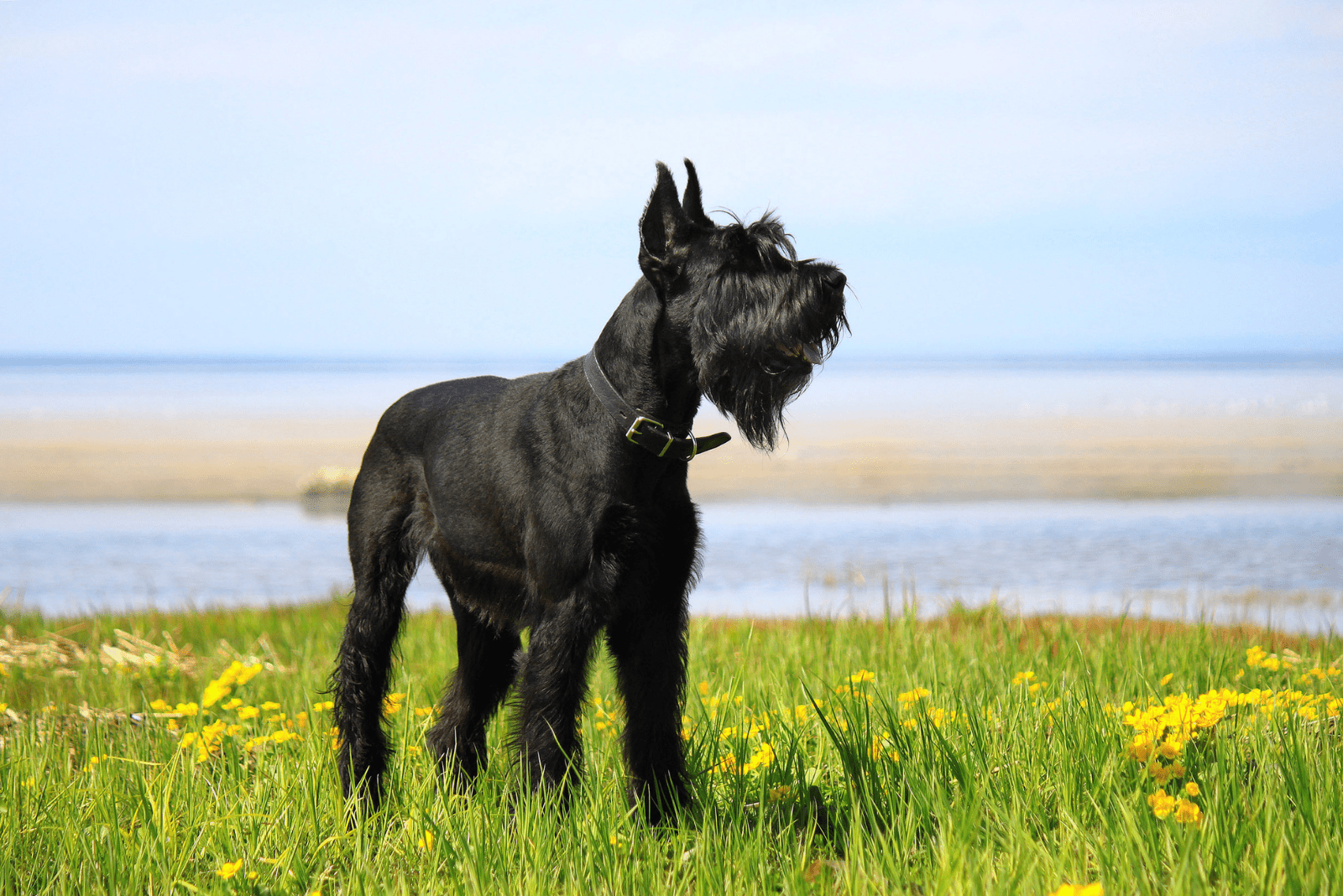
The third Schnauzer breed for today is the Giant Schnauzer, or as Germans like to call it – “der Riesenschnauzer”.
History
In contrast to its standard and miniature counterparts, the Giant Schnauzer is the result of crossing many different dog breeds like Boxers, black German Shepherds, Great Danes, Rottweilers, Doberman Pinschers, and Standard Schnauzers.
With such a versatile gene pool, the Giant Schnauzer became an excellent working dog that was used in search and rescue, as well as other military work during both world wars.
Appearance
Reaching up to 24 inches in height, the Giant Schnauzer is a large dog. Most breeders have their Giant Schnauzers undergo ear cropping and tail docking procedures to achieve the appearance of breed standards.
Giant Schnauzers inherit a thick double coat that comes in a variety of funky colors. Their head is large, with a long muzzle enriched with a fabulous mustache.
Temperament
Giant Schnauzers are true gentle giants that pretend that they are lap dogs. Highly intelligent and trainable, the Giant Schnauzer makes a loyal and obedient canine companion.
14. Westphalian Dachsbracke
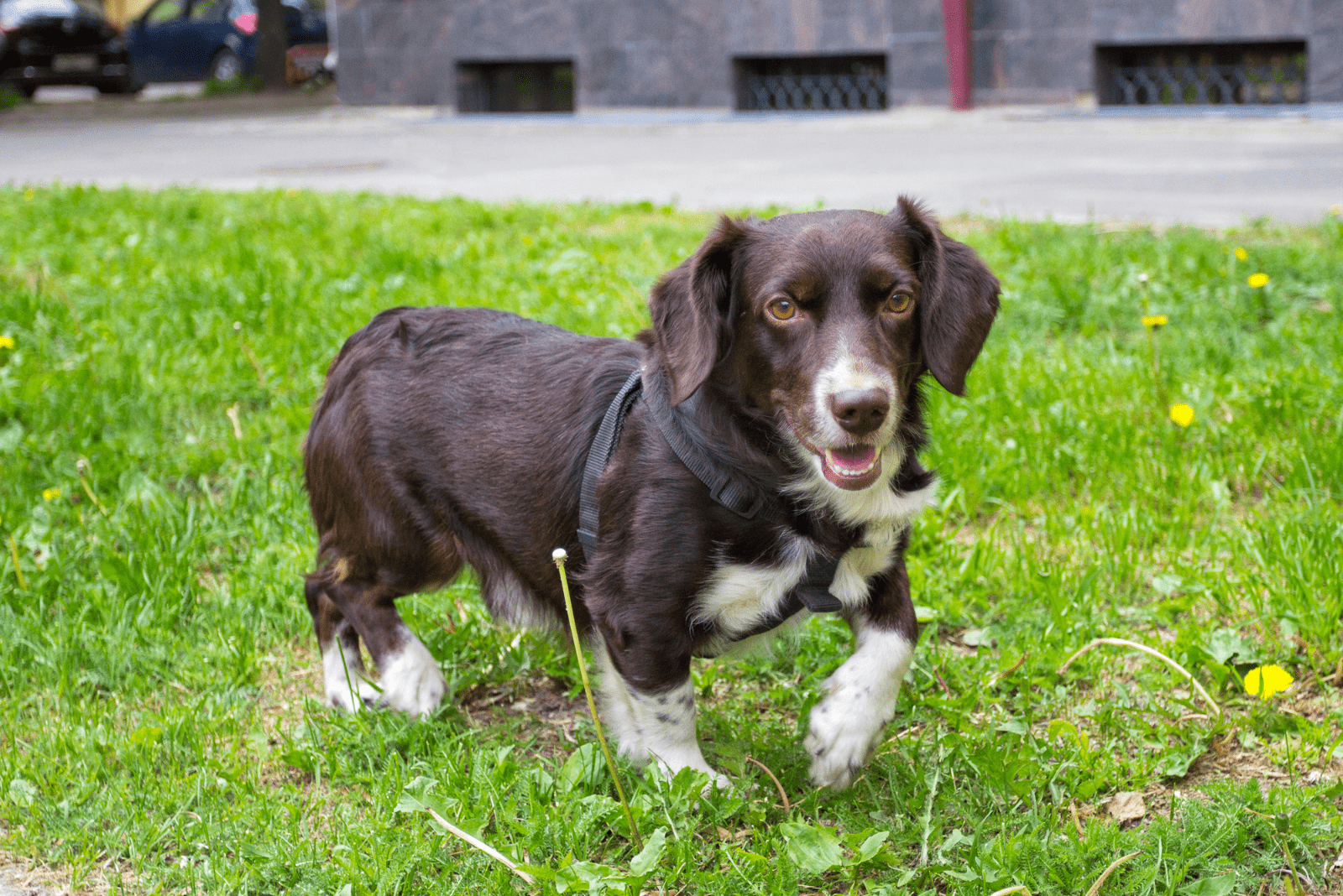
Hello, shorties! Finally, a short pup with the cutest puppy face. Meet the Westphalian Dachsbracke – a friendly little pooch with a wonderful temperament.
History
As its name implies, the Westphalian Dachsbracke was developed in the Westphalia region in Germany. Cynologists hypothesize that this pooch was brought up by crossing a short-legged Dachshund with a tall Deutsche Bracke dog.
Appearance
As a great hunting dog, the Westphalian Dachsbracke’s body is built to hunt small prey. Its legs are short, its ears are floppy, and its muzzle is elongated, making it perfect for sniffing around holes.
Due to its elongated body that rests on short legs, the Wesphalian Dachshbracke is prone to various disorders of the spinal cord.
Temperament
Besides its hunting skills, the Westphalian Dachsbracke is an incredible scenthound. This means that it might want to follow its nose, while disobeying its owner’s commands.
Other than that, the Westphalian Dachsbracke makes a pawesome companion that is always ready to go wherever your heart desires!
15. Pomeranian
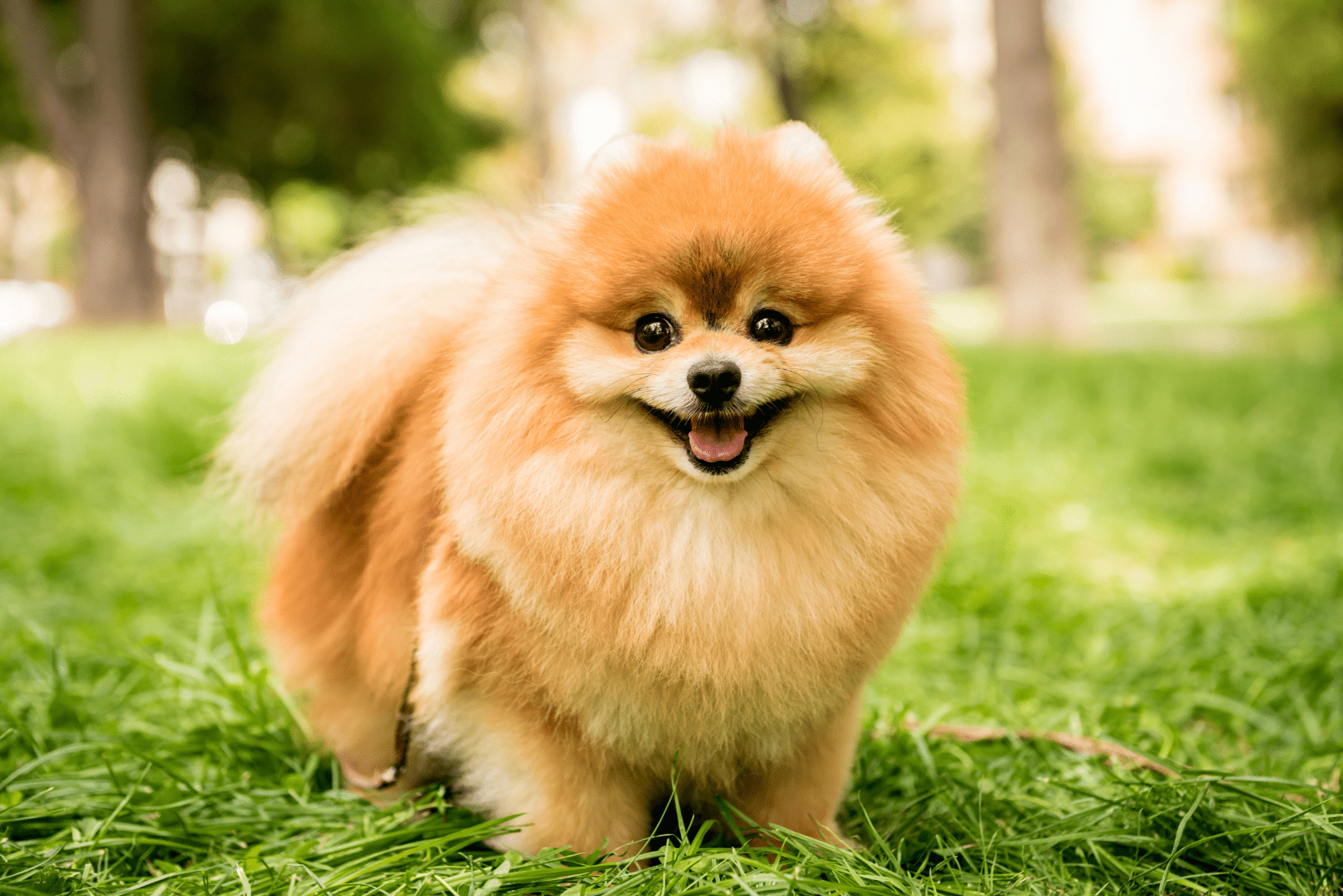
Wonderful Pom Poms have become very popular around the globe. Here’s what makes these fluffballs so special!
History
The Pomeranian dog breed originates from… well, Pomerania – a region between Germany and Poland that does not officially exist anymore (nowadays, it’s Western Germany).
Descending from Nordic Spitz-type dogs, early Pomeranians were somewhat larger than today’s Pomeranians. They used to pull sleds, herd livestock, and provide protection to households.
Appearance
Ever wondered how big Pomeranians get? Well, not as big as they pretend they are! Poms are small dogs with big personalities.
They inherit a soft and fluffy coat from their Nordic ancestors that are usually white. However, years of selective breeding resulted in the development of unique merle Pomeranians!
The Pomeranian’s small, but extremely soft ears are pointed upwards, while its eyes and nose are usually colored dark brown to black.
Temperament
Fierce and adorable – that’s what Pomeranians are.
Their guarding instincts make Pomeranians incredible watchdogs and small-sized bodyguards! You will always feel safe with a courageous Pomeranian by your side.
Read Also: The Ultimate German Shepherd Pomeranian Mix Guide
16. White Shepherd
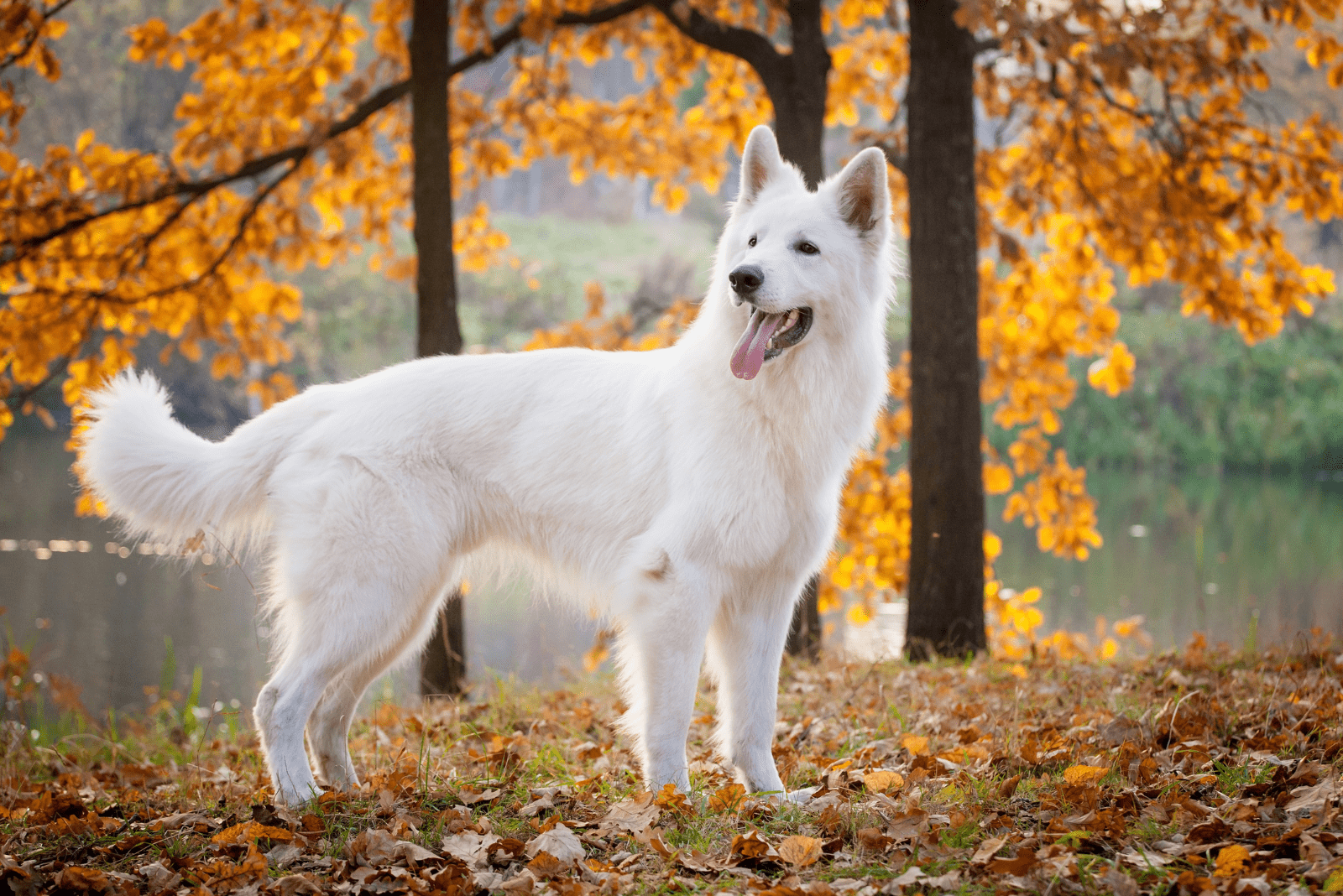
If you think that we’re talking about a white German Shepherd, think again! The White Shepherd is a German breed that has been bred in the U.S.
History
The story about the White Shepherd might sound confusing because some kennel clubs recognize it as a breed, while some recognize it as a variety of the German Shepherd dog breed.
The development of the German Shepherd breed gave birth to white German Shepherd pups that were selectively bred to develop the White Shepherd.
Appearance
The United Kennel Club has put up White Shepherd breed standards that describe this herding dog as a medium-sized canine. White Shepherds grow up to 25 inches in height, and weigh between 70 and 80 pounds.
White Shepherds usually inherit a short double coat, with longer hairs on the tail, limbs, and neck. Due to their white coat, White Shepherds may be prone to skin issues.
Temperament
With bubbly personalities, White Shepherds are loved by both adults and children. They are very trainable, and they make great working dogs.
White Shepherds love to cuddle, and they may also want to sleep with their bum facing you!
17. Saarloos Wolfdog
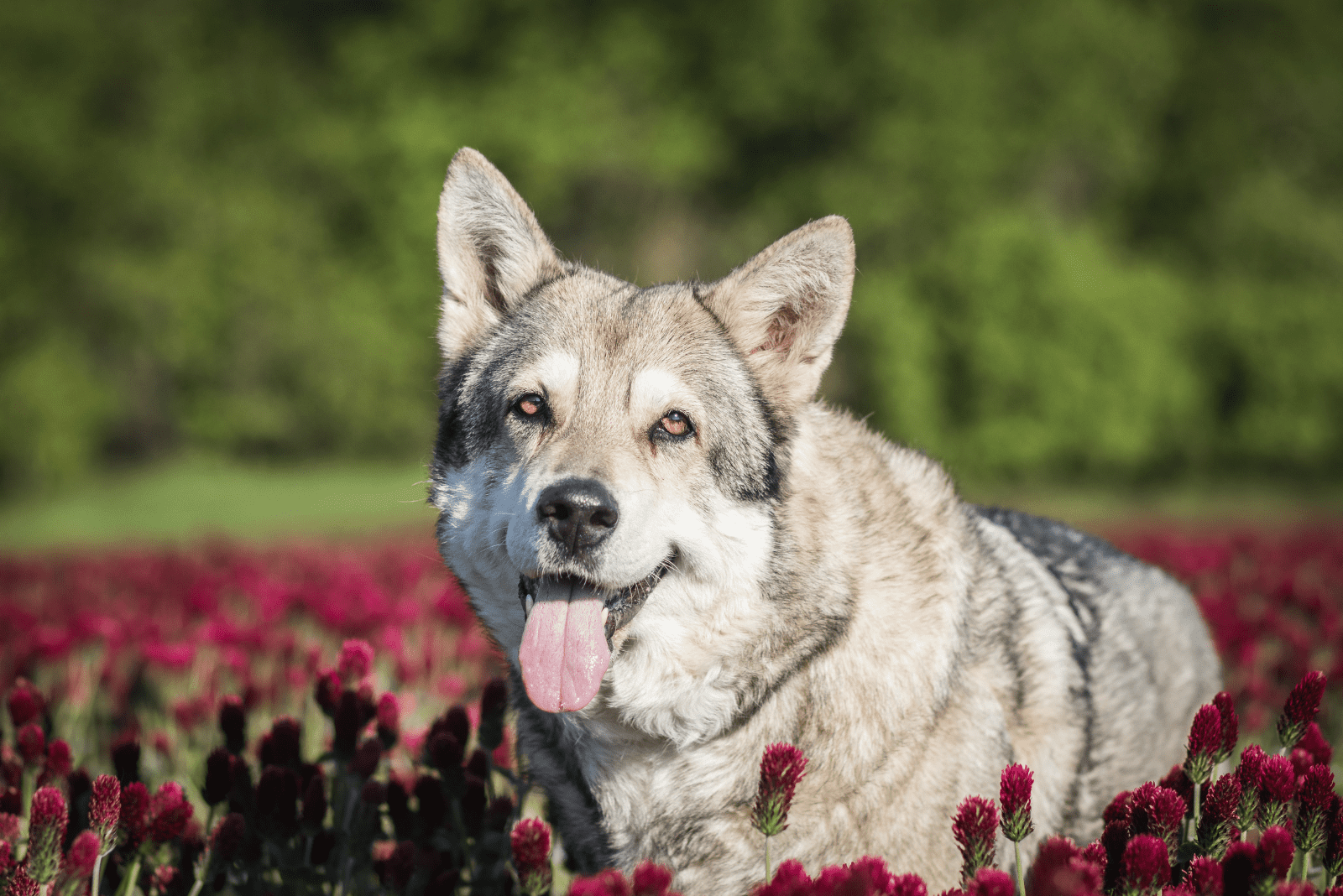
Meet one of the finest wolf-like dog breeds in the whole world. The Saarloos Wolfdog is in a way, a real wolf!
History
Take a guess — did someone actually cross a German Shepherd and a wolf? Yep, it was Mr. Leendert Saarloos who did this back in 1935! This is a part Dutch, part German dog breed.
The first generation of Saarloos Wolfdogs gave birth to a semi-wild litter that was later crossed only with German Shepherd dogs.
Over 50 years later, it was recognized by the FCI, who put up the official Saarloos Wolfdog breed standards.
Appearance
The Saarloos Wolfdog looks more like a wild wolf than a domesticated dog. Its double coat is thick, and it usually comes in shades of gray.
Its body is large, reaching up to 30 inches in height. Despite their large size, Saarloos Wolfdogs may inherit a health condition called Pituitary Dwarfism that prevents their body from growing.
Temperament
The Saarloos Wolfdog is an interesting combination of wild and domestic dogs that surprisingly results in a not-so-hard working dog.
The Saarloos Wolfhound is a very energetic canine that needs early socialization. Given its wild heritage, this dog must be well-trained and brought up.
18. Affenpinscher
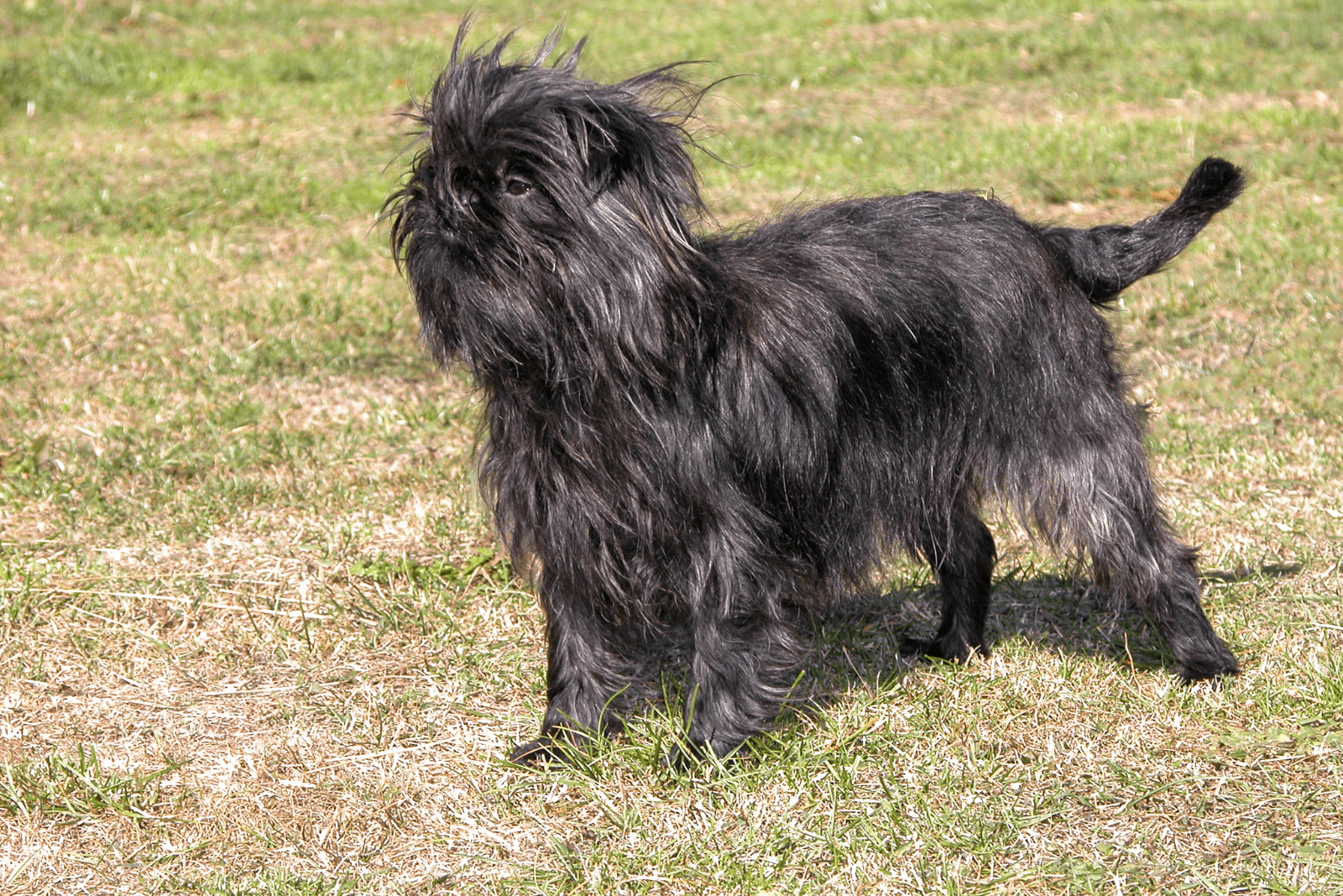
Okay, hear me out. “Affen” means monkey, and “Pinscher” means terrier. So, the Affenpinscher is a monkey terrier! Wait, what?
The Affenpinscher may be one of the world’s weirdest dog breeds, but it sure is a unique little pup!
History
The Affenpinscher is not a new breed. This monkey-like little dog appeared back in the 17th century.
It is said that the Affenpinscher’s genetic pool has fragments of genes from the Brussels Griffon dog and the Miniature Schnauzer.
Appearance
The reason why the Affenpinscher is called this is because its snout resembles a cute monkey. The Affenpinscher has a unique blend of coat colors such as gray, silver, red, black and tan, or beige.
Although it appears fluffy, the Affenpinscher inherits a rough coat that isn’t very soft to touch. Because of its small size, the Affenpinscher might be prone to canine Legg-Calve-Perthes disease.
Temperament
The Affenpinscher is a small pup, but that doesn’t mean that its attitude is small! As an adventurous and outgoing pup, the Affenpinscher can get on a stubborn streak.
Overall, its adorable looks combined with its sweet personality make the Affenpinscher a great companion dog.
19. Small Münsterländer Pointer
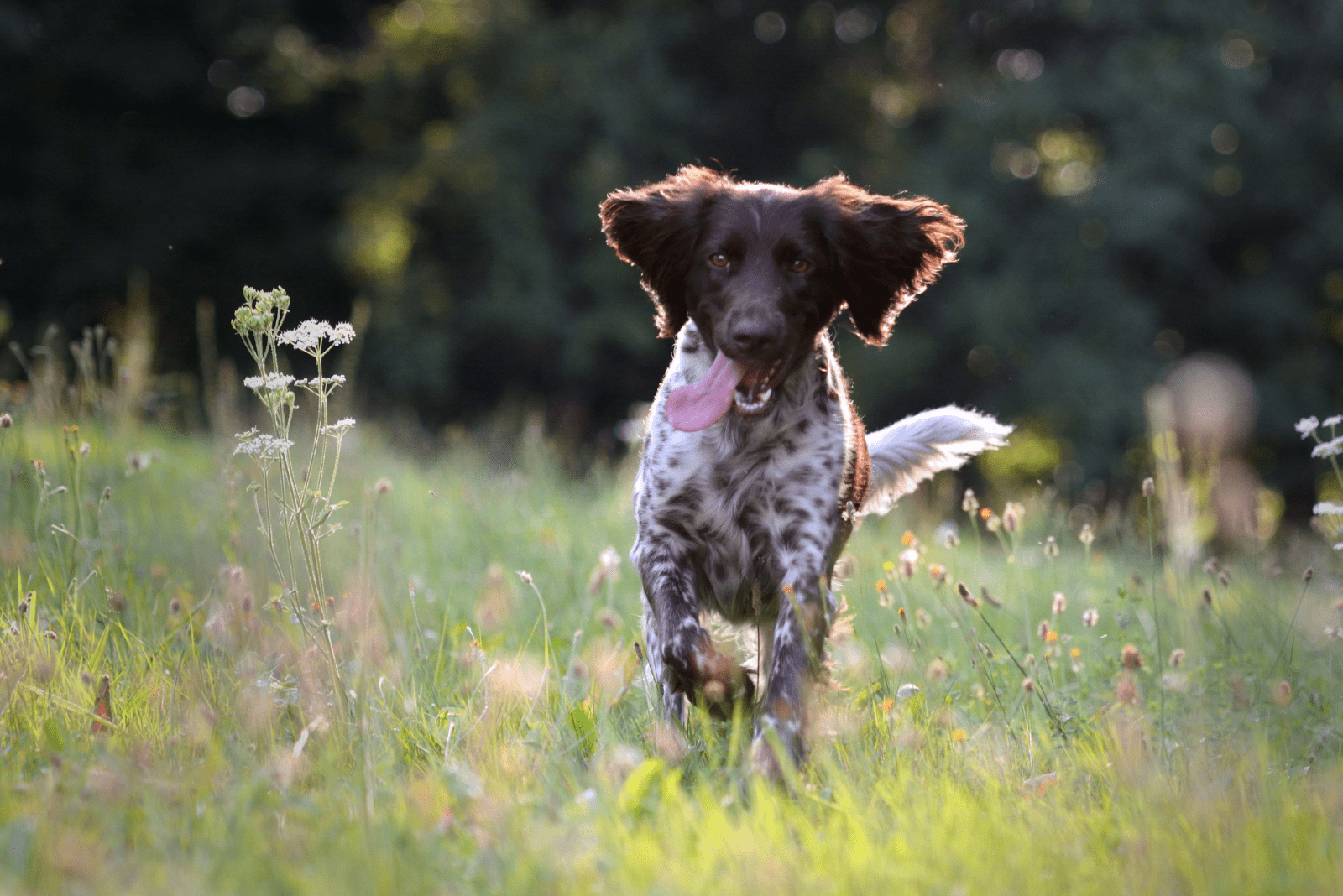
Meet Kleiner Münsterländer! – a small pointer dog that kind of resembles the German Shorthaired Pointer. The Small Münsterländer Pointer is not only a pointer, but it is also a retriever and an excellent hunter.
History
The Münster area in North West Germany is home to this wonderful pointer. It is believed that this pooch was developed by breeding its large counterpart — the Large Münsterländer Pointer, with Spaniel-type dogs.
Small Münsterländer Pointer development took place in the early 20th, making this German dog breed a bit younger than the rest on this list.
Appearance
Despite its name, the Small Münsterländer Pointer is actually a medium-sized dog. Its growth is similar to the Cocker Spaniel’s growth.
What I find the cutest about the Small Münsterländer Pointer’s appearance are its floppy ears covered with wavy hair. Its coat comes in medium length, and it is spotted all over, making the Small Münsterländer Pointer a sight to behold!
Temperament
Kind and well-mannered, the Small Münsterländer Pointer is a great canine candidate for families who are looking for an adventurous and loving dog.
The Small Münsterländer Pointer gets along well with children, and it can be socialized well enough to play with smaller animals (despite its high prey drive).
20. Large Münsterländer Pointer
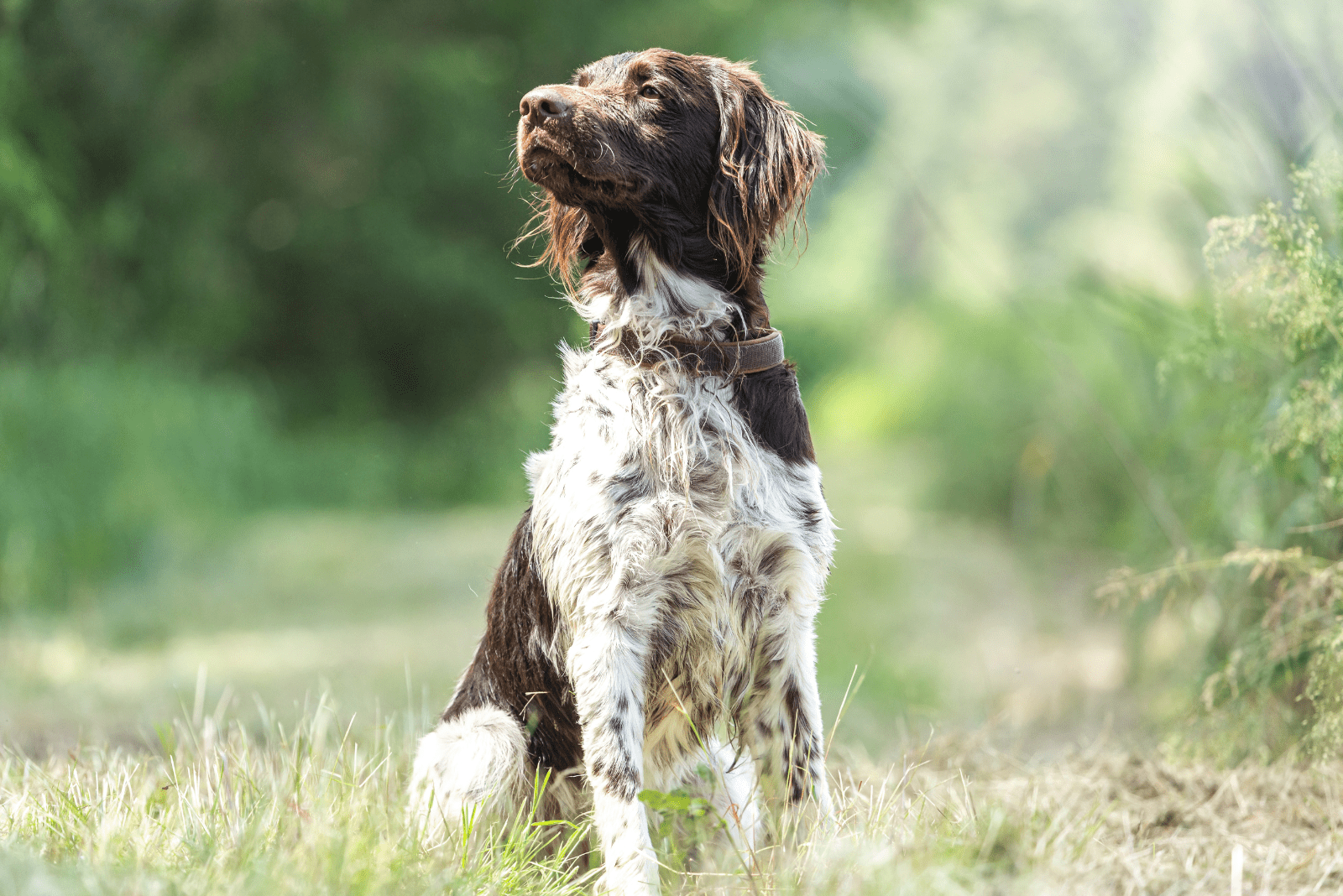
Say “Hallo” to the Großer Münsterländer Hund. This incredible pointer and gun dog made its way to the U.S. back in the 1960s. Its versatile abilities enrolled the Large Münsterländer into the North American Versatile Hunting Dog Association (NAVHDA).
History
In contrast to its small counterpart, the Large Münsterländer Pointer has a different history. In fact, the Large Münsterländer isn’t actually related to the Small Münsterländer Pointer.
The Large Münsterländer also comes from the German Münster area. This gun dog started off as a variant of the German Longhaired Pointer dog, but it was quickly recognized as a separate breed.
Appearance
According to the FCI Large Münsterländer breed standards, this gun dog inherits a large, muscular body that is covered with a long, dense coat.
The Large Münsterländer’s colors are similar to the German Shorthaired Pointer colors. A spotted coat with white patches is what makes the Large Münsterländer Pointer similar to other German pointer dogs.
Temperament
A sweet pooch with a loving heart — the Large Münsterländer Pointer is more than a gun dog. It is beloved by all families both in Europe and in the United States.
The Large Münsterländer Pointer is a gentle dog that is known as a wonderful playmate for children of all ages.
21. Eurasier
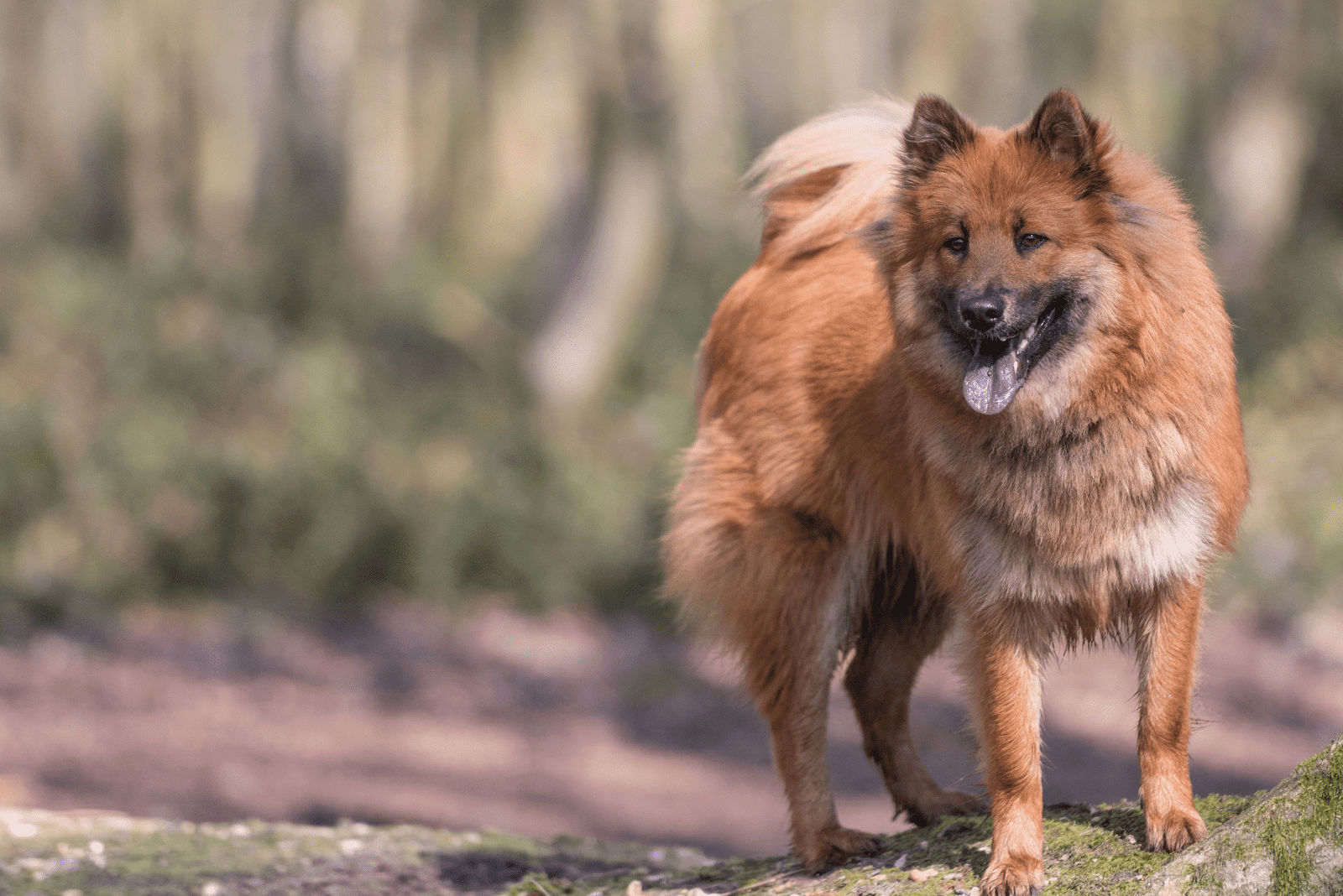
We are back with another Spitz-type dog that brings along all the fluff! At first sight, the Eurasier resembles the Chow Chow and the Keeshond. However, these are all different breeds.
History
Appearing in the 1960s, the Eurasier is relatively new when compared to other German dog breeds. Julius Wipfel, and his team, were focused on Spitz-type dogs and wanted to create a new Spitz dog breed. And, so they did!
They mixed a purebred Chow Chow with a purebred Keeshond that resulted in a unique hybrid. The Chow Chow Keeshond hybrid was then crossed with a purebred Samoyed, creating the Eurasier that we know today!
Appearance
The Eurasier is one of those big fluffy dog breeds that are asking to be cuddled! Actually, the official FCI Eurasier breed standards state that this dog is a medium-sized dog.
The reason why some paw lovers mistake the Eurasier for the Chow Chow is because it inherits similar colors to those we see in Chow Chow colors.
Temperament
The Eurasier is an amazing family dog that is pretty reserved around strangers. It can become annoyed quickly, so it’s best to socialize the Eurasier as early as eight weeks of age.
Besides that, the Eurasier is a loving dog that’s full of energy!
22. Kromfohrländer
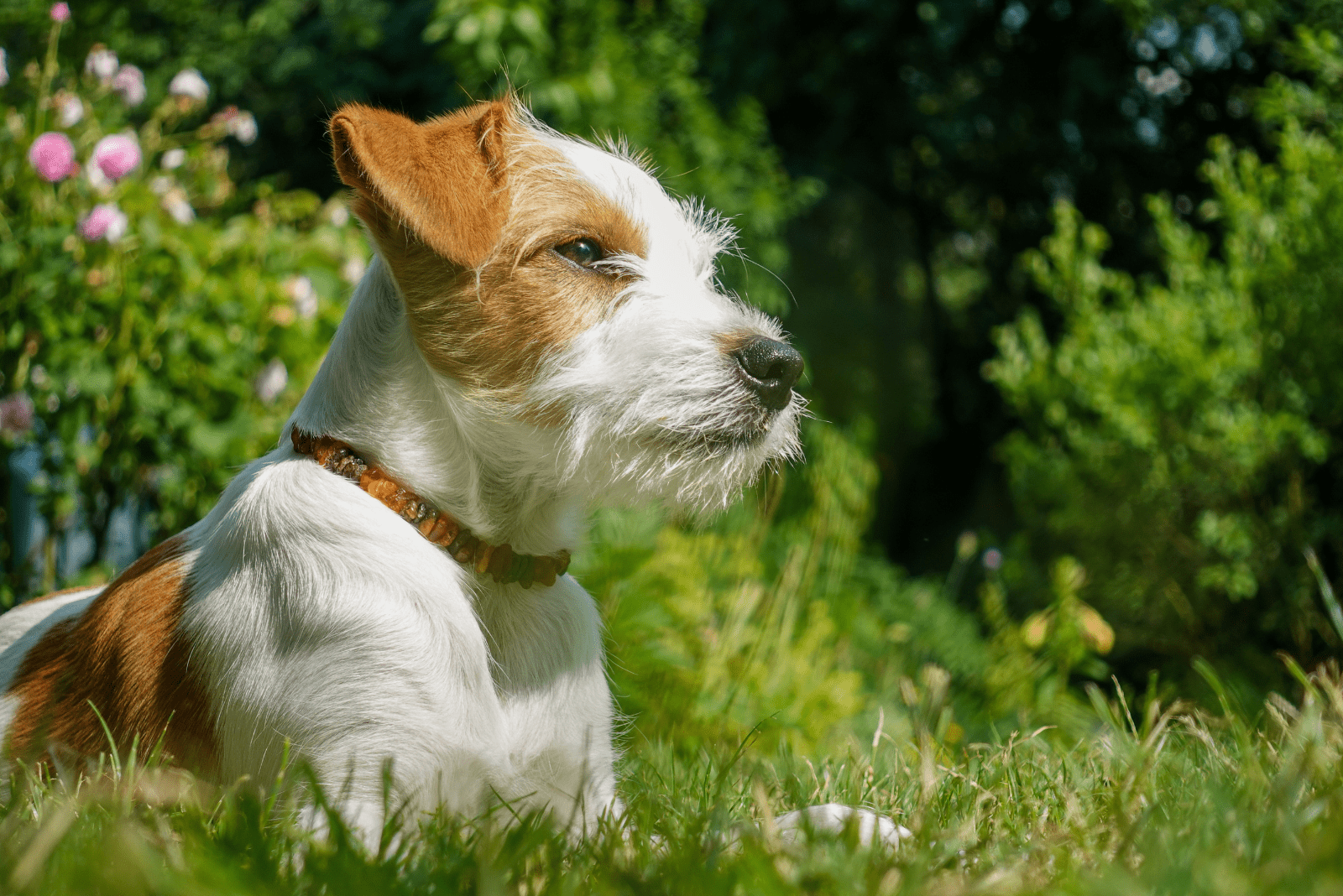
Alright, let’s try to pronounce this together: Crohm – for – lander! The name is given to this companion dog because of the region it comes from — the Krom Fohr region, in Western Germany.
History
The Kromfohrländer is a unique German dog breed that isn’t seen quite often. And, its story is one-of-a-kind.
The Kromfohrländer originates from a military dog that kept company with American soldiers during the war. It is said that this military dog somehow got lost, and was later saved by a woman named Ilse Shleifenbaum.
Ilse took to breeding this dog with different Terrier and Griffon-type breeds, which eventually gave birth to the original Kromfohrländer.
Appearance
The Kromfohrländer’s body is small to medium in size. It is covered with a white, coarse, medium-long coat that features golden to orange-colored patches on its back, legs, and abdomen.
Besides the rough coat, the Kromfohrländer also comes in a smooth-coat variant. The Kromfohrländer FCI breed standards describe it as a strong and well-balanced companion dog.
Temperament
The Kromfohrländer is such a loving dog that it took the United States by storm. Its bubbly, people-pleasing, yet at times, stubborn personality brought the establishment of the Kromfohrlander Club of America.
Although considered a rare breed, lots of dog lovers in the United States are considering adopting a sweet-natured Kromi!
23. Toy Poodle

Oh, we’re not talking about a toy. We’re talking about a purebred dog that looks like a toy! You might be surprised to find out that the Poodle is actually a German dog breed.
History
The Toy Poodle became popular in the 20th century when Poodle breeders decided to make a smaller version of the Miniature Poodle.
Through selective breeding, they finally developed a Toy Poodle that became Germany’s favorite companion dog. However, this led to Toy Poodles developing congenital health issues, such as canine Addison’s disease, and thyroid issues.
Appearance
As its name implies, the Toy Poodle is a very small dog — it can reach only 10 inches in height! Its coat is fluffy and curly, perfect for making the cutest Poodle haircuts!
Toy Poodles come in a variety of coat colors. But, paw lovers from the United States seem to love the black Toy Poodle variant the most (it is also the most common Toy Poodle color).
To achieve the perfect appearance, Toy Poodle breeders thoughtfully created quality breeding programs. So, make sure to search for such breeders!
Temperament
Energetic, smart, and full of pawsitive self-esteem!, the Toy Poodle knows how to get around. This toy breed is loved by everyone, and it makes an amazing companion dog.
Toy Poodles are very attached to their owner, so don’t be surprised if your puppy cries at night because it is prone to suffering from separation anxiety.
24. Miniature Poodle
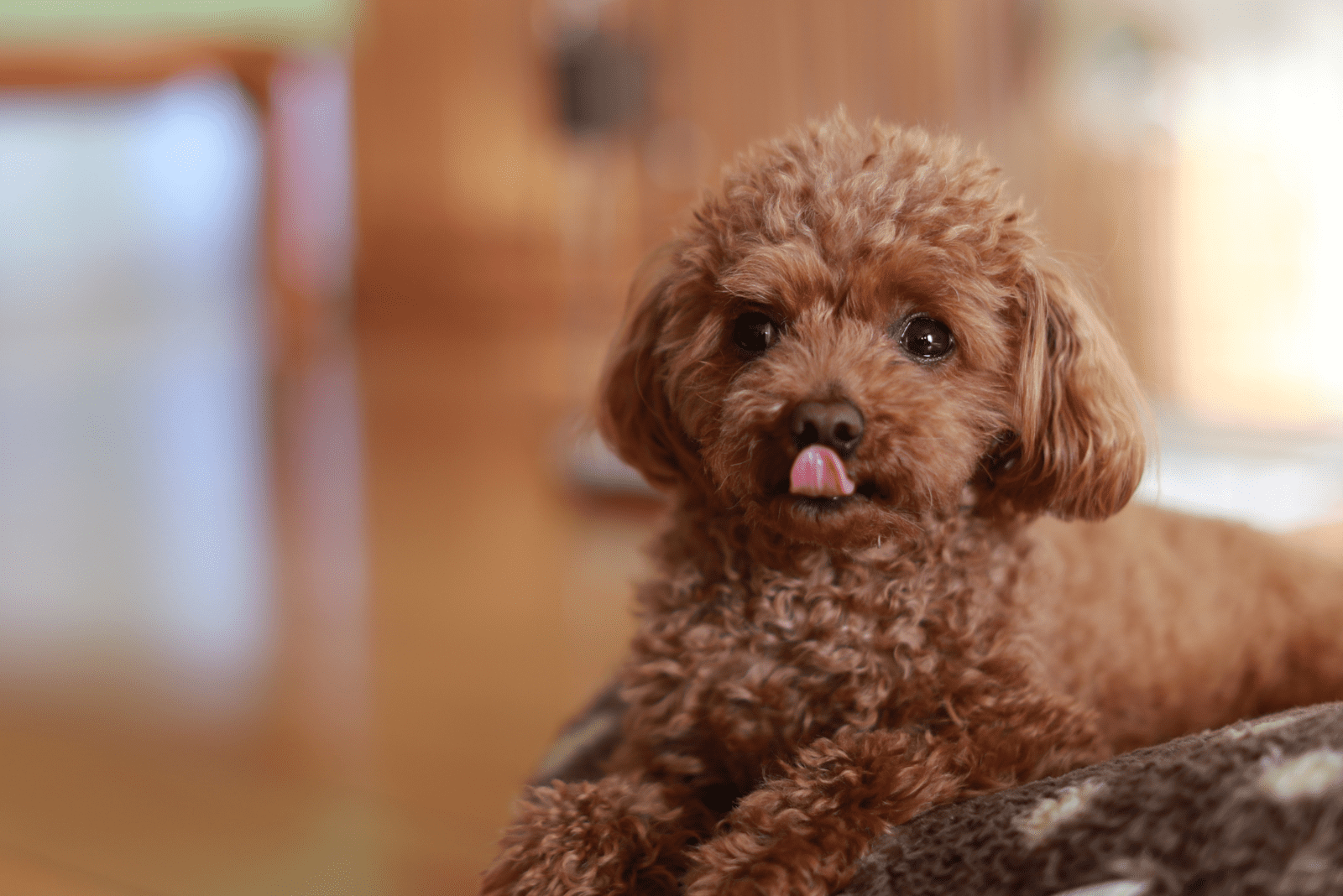
Let’s shift to a bigger version of the Toy Poodle — the Miniature Poodle. In contrast to its toy counterpart, the Mini Poodle is five inches taller!
History
Miniature Poodles derive from crossing the smallest Standard Poodles, just as it is the case with Toy Poodles deriving from Mini Poodles.
It all started in the late 1700s. It is believed that Standard Poodles were imported from Germany to France where they were downsized to Miniature Poodles.
Appearance
Its remarkable looks and hypoallergenic coat properties inspired breeders to create many wonderful Miniature Poodle mixes (also known as Doodle mixes).
Due to their small head and big eyes, Miniature Poodles are prone to inherit eye problems like canine trichiasis, lacrimal duct atresia, cataracts, and glaucoma.
Temperament
Mini Poodles are energetic pooches that love physical activity. All purebred Miniature Poodles inherit remarkable, fun-loving personalities.
To be on the safe side, it’s best to search for the most reputable Miniature Poodle breeders to purchase your canine from!
25. Standard Poodle
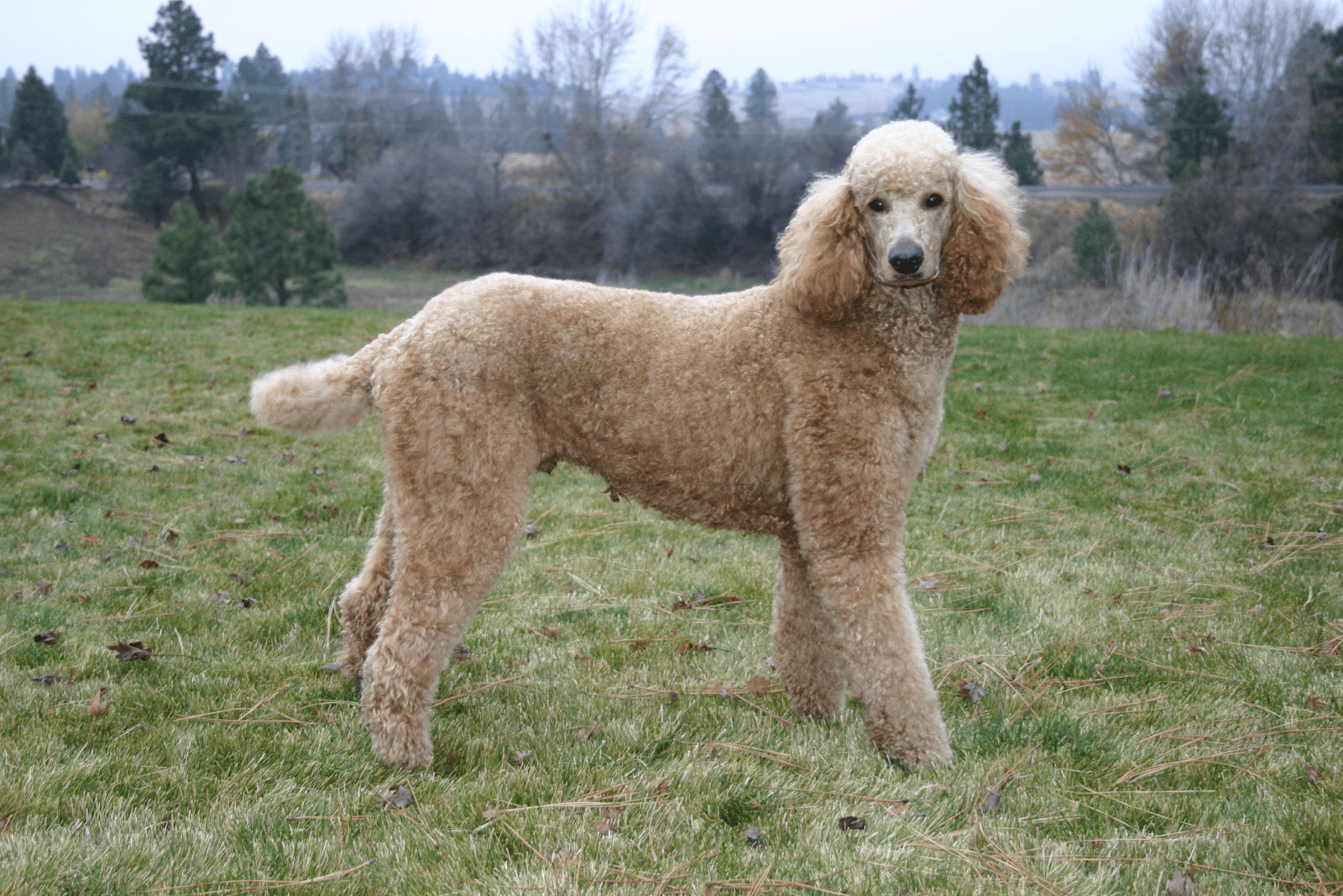
The Standard Poodle is the golden middle of the Poodle dog breed. It’s also the most popular Poodle version in the United States.
History
The Standard Poodle (also known as Pudel) descends from German’s water dogs. The name itself refers to puddles, which means that Poodles were good swimmers and retrievers.
The Standard Poodle was first introduced to the United States back in the 1800s. Specifically, this fluffy dog breed was accepted by the American Kennel Club in 1887.
Appearance
Unlike its Mini and Toy counterparts, the Standard Poodle is much taller — reaching between 18 and 24 inches in height.
The Standard Poodle’s coat is as soft as a feather! It is curly and dense, with almost water-resistant properties. There are over thirty funky Poodle colors that will take your breath away! One of the rarest color variants is the Standard Phantom Poodle.
Temperament
Due to their loving temperament, Standard Poodles made it to the top on America’s favorite dog breeds list. Standard Poodles enjoy spending time with their human pack, and their energy levels are over the roof!
The Standard Poodle’s sweet nature and fancy looks made paw lovers go crazy for various Poodle crossbreeds!
26. Large Poodle
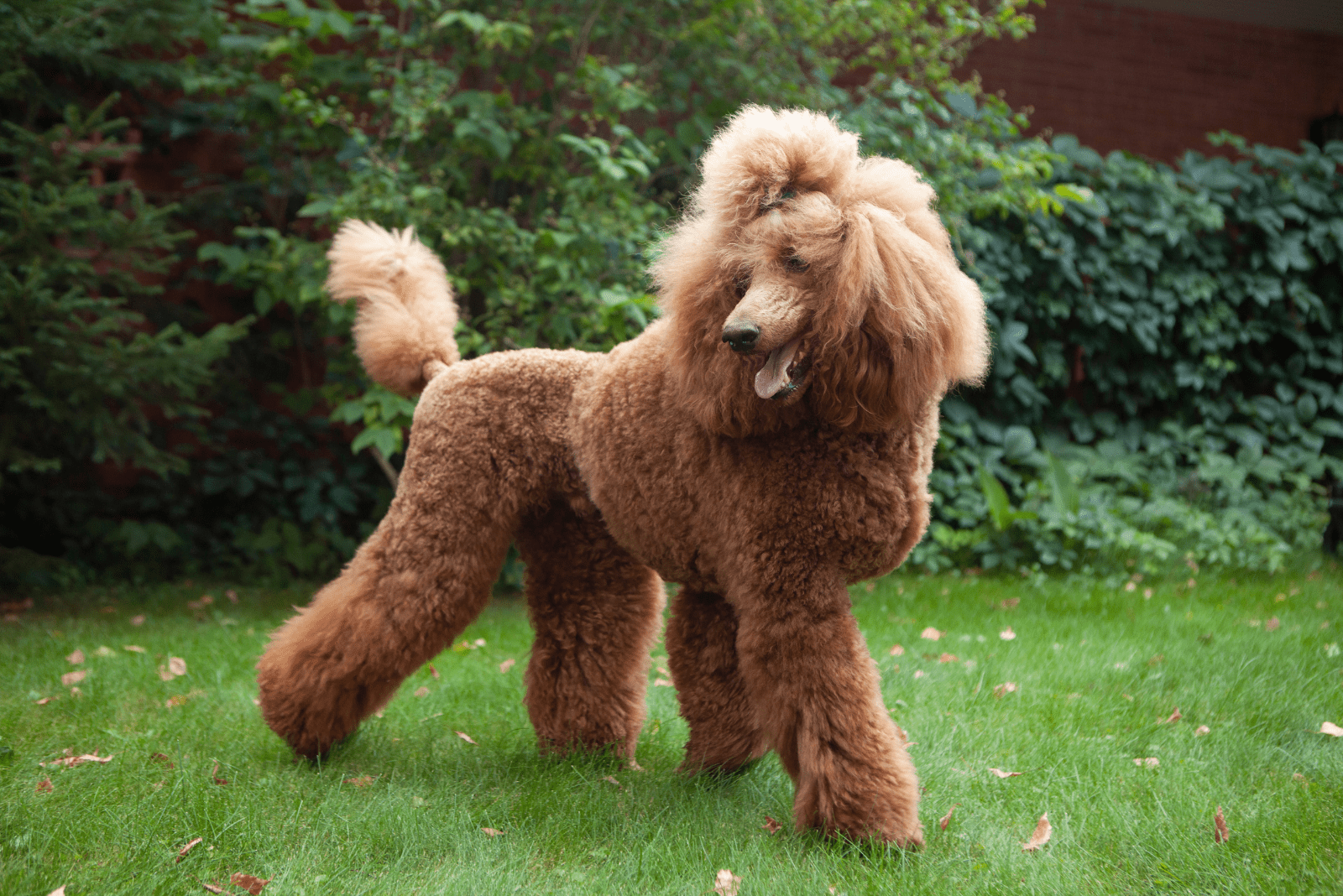
Large Poodles are often referred to as Giant Poodles because they are — giant! Some dog lovers believe that this is a separate Poodle breed, while others believe it is just a bigger version of the Standard Poodle.
History
Due to the fact that the American Kennel Club only recognizes three Poodle sizes (Toy, Mini, and Standard), there is no place for a giant Poodle in this club.
However, the Giant Poodles reserved their place in our hearts way back in the 17th century.
Appearance
Reaching up to a whopping 28 inches in height, the Large Poodle is often believed to be a crossbreed. But, we’re talking about a purebred Standard Poodle that seems to have grown large in size!
Large Poodles inherit a denser coat than their standard, toy, and mini counterparts. They are extremely fluffy, and their coat is great for allergy sufferers!
Due to their large size, these Poodles are prone to hip and elbow dysplasia, as well as canine arthritis.
Temperament
Large Poodles are the definition of gentle-giant dogs that are full of love to give! They are affectionate and thoughtful around smaller animals and children.
Extremely intelligent, large Poodles are easily trainable and they do well in all sorts of agility training.
27. Löwchen

Known as the rarest dog in the world back in the 70s, the Löwchen made a great comeback. Nowadays, this pup warms the laps of many American pet parents.
History
It is believed that the first painting of the little lion dog dates back to the 1500s. Due to the fact that it belongs to the Bichon family, the Löwchen was probably developed by combining Bichon-like dogs.
Appearance
The Löwchen looks like a Havanese and a Shih Tzu dog. Its straight, dense coat spreads itself down to the floor.
Due to the fact that its name translates to “lion dog”, a Löwchen’s main is often styled so it looks like a lion’s mane.
Because they appear similar, some Havanese breeders also offer adorable Löwchen puppies!
Temperament
This little lion dog is a real sweetheart. A loving dog with a sound temperament, the Löwchen is simply the perfect canine companion.
The Löwchen enjoys its owner’s (and everyone’s) attention. It might feel left out if it’s alone, developing separation anxiety that can turn into destructive behavior.
28. Hovawart
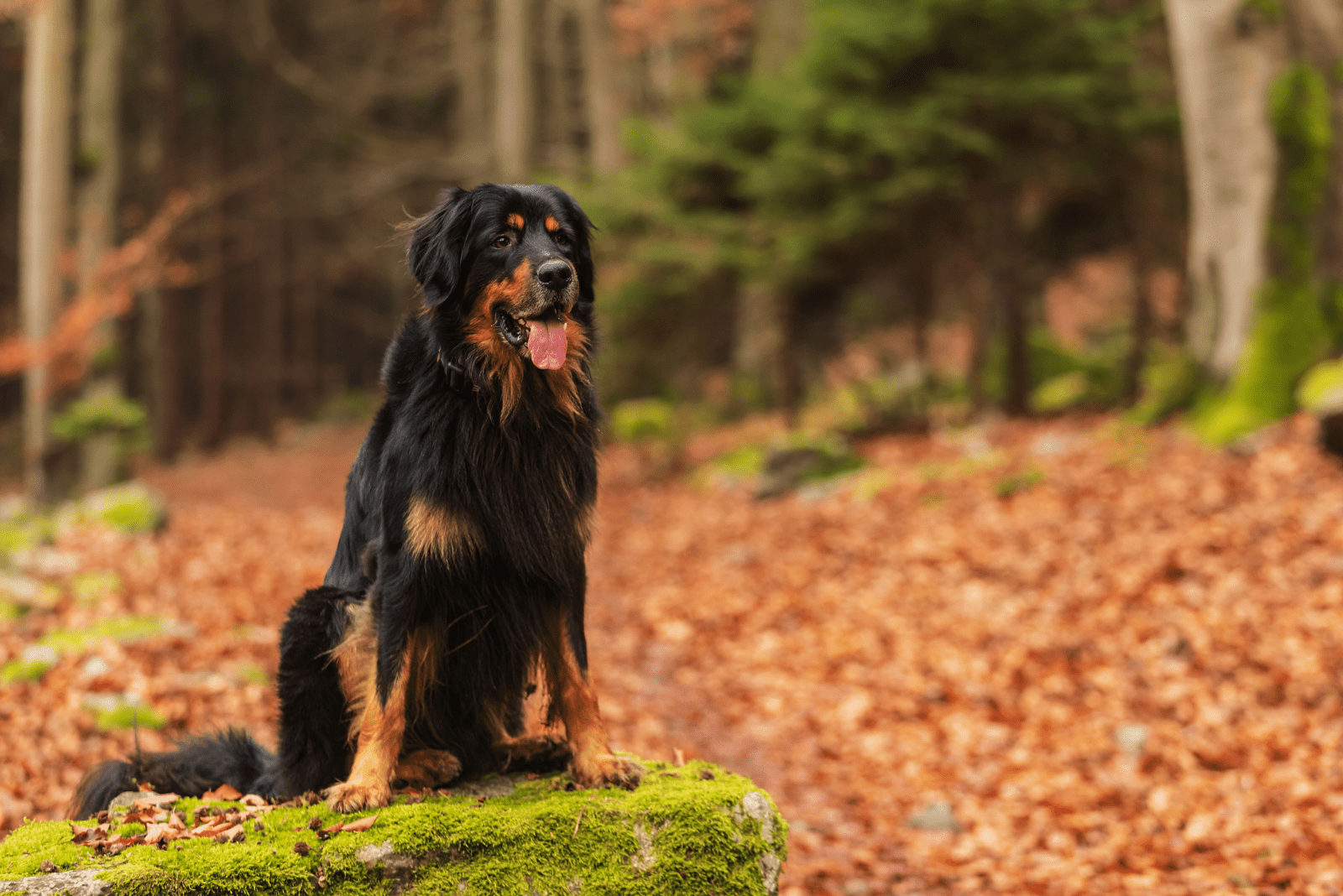
Meet the perfect watchdog — the Hovawart. This is such a great watchdog that it has the word “watchman” in its name (Wart-Wächter).
History
Bred as a watchdog, the Hovawart has been guarding German homes since 1922. Not only was the Hovawart a great watchdog, but it was also used as a herding dog.
As a working dog breed, there was no task too difficult for a Hovawart to do!
Appearance
The Hovawart inherits a muscular build. It’s a strong, large dog that can weigh up to 90 pounds. Despite its large size, the Hovawart is considered a healthy dog breed, though some Hovawart dogs may acquire canine hypothyroidism as they age.
The Hovawart dog looks a lot like the field Golden Retriever, but in black and tan coat color!
Temperament
A large body combined with a puppy personality make the Hovawart a real snuggle bug! It’s a very friendly and outgoing pooch towards those whom it is familiar with.
The Hovawart may be very uncomfortable towards strangers, and it may not get along well with small animals.
29. American Eskimo Dog
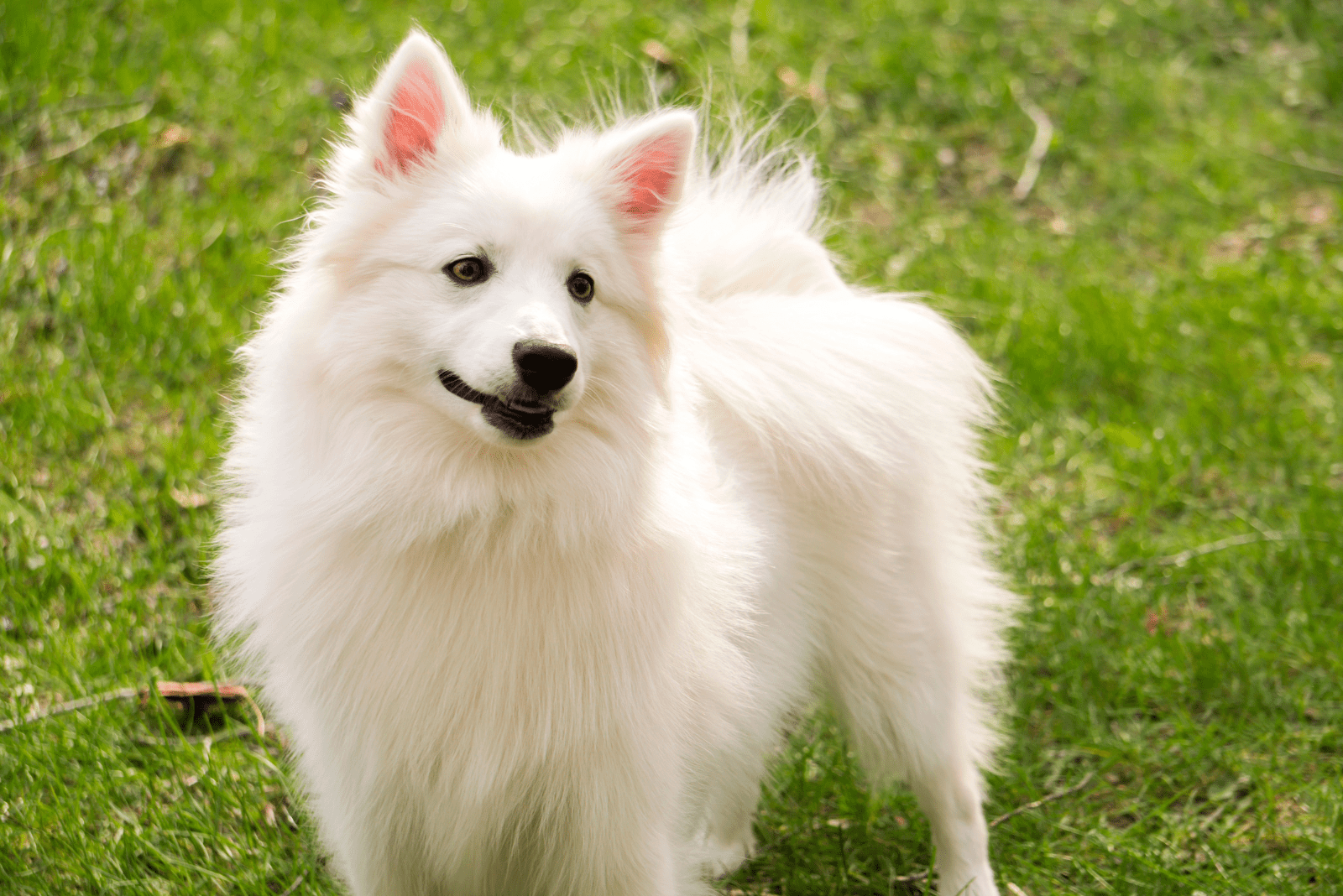
Let’s not get confused here. Even though the name says “American”, this dog is actually German. So, what gives?
History
Originally bred in Germany as descendants from Northern Spitz-type dogs, American Eskimo dogs made their way to the United States back in the 19th century.
Becoming extremely popular, the American Eskimo dog breed made its way to many American families.
Appearance
A small, fluffy dog breed with the softest coat out there — the American Eskimo will make you go “aww”!
A lot of American Eskimo dog’s characteristics resemble those of the Japanese Spitz and the Samoyed. However, the American Eskimo dog is smaller than the Samoyed, but a bit bigger than the Japanese Spitz.
Temperament
Extremely loyal and sometimes aloof, the American Eskimo dog is a unique blend of all the pawsitive traits. It gets along perfectly well with children, but the American Eskimo’s alertness can make it wary of strangers.
30. Jagdterrier
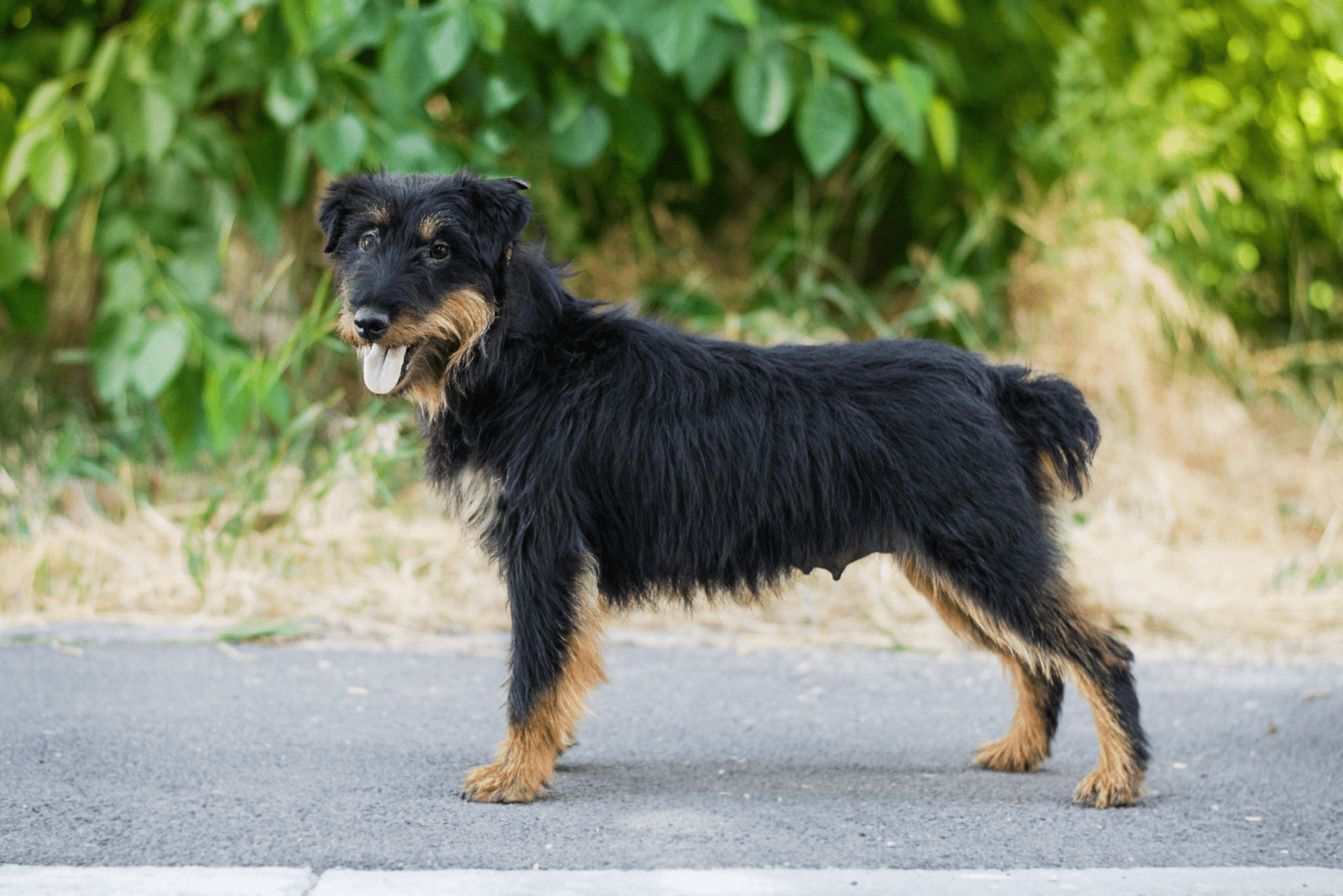
The Jagdterrier is an excellent hunting dog; hence, the “Jagd” (hunting) in its name. Take a look at this brave pooch!
History
It seems that the Jagdterrier is the newest hunting dog breed. It appeared in the 1920s when a group of German hunters started breeding different hunting breeds.
When the Jagdterrier first appeared, it was used in hunting and retrieving activities.
Appearance
Its long muzzle and small head that is covered in coarse hair makes the Jagdterrier look like any other terrier dog breed. However, its distinct body posture and coat colors make it stand out among other hunting dogs.
Being a small dog, the Jagdterrier is able to get itself into all sorts of holes and dens.
Temperament
It takes a lot of energy and strong will to be a top-notch hunting dog! The Jagdterrier has it all. This lively pooch shows high energy levels that need to be released through daily physical activity.
Due to their active nature, Jagdterriers are prone to getting ligament and musculotendinous injuries.
31. Elo Dog

Well, ‘elo dog! Have you ever heard about this German dog breed? The Elo dog is a fox-like, fluffy dog breed that is somewhat popular in Europe, but very rare in the United States.
History
The Elo Dog was created in 1987 by dog breeders and enthusiasts, Marita and Heinz Szobries.
Their love for dogs resulted in the development of the Elo Dog that is a combination of three purebreds: the Eurasier, the Old English Sheepdog, and the Chow Chow. They also added a purebred Samoyed to the mix.
Appearance
Looking at the Elo Dog, we can clearly see that its weight is similar to the Chow Chow’s weight and size. Built of a medium size, the Elo Dog carries a fluffy double coat that requires frequent maintenance.
Elo Dogs range from brown, white and black, gray and white, as well as beautiful white and chocolate hues.
Temperament
Playful and witty, the Elo Dog makes a wonderful family dog that loves being around children. An Elo’s trainable personality makes it easier for beginner owners who decide to adopt this unique dog.
32. German Pinscher
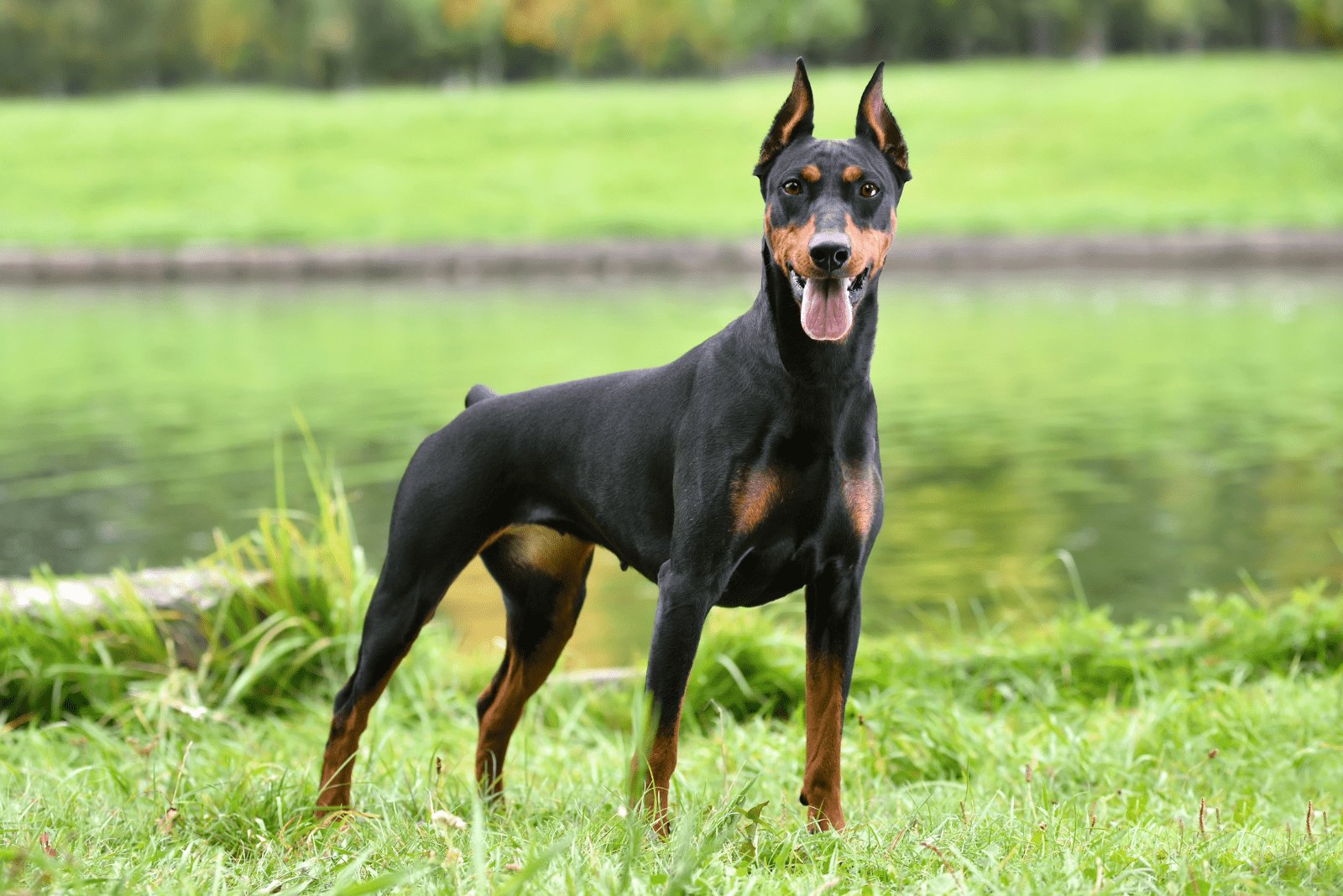
No, it’s not a Doberman Pinscher, but it is its smaller version — the German Pinscher. Let’s say a few things about this German dog breed.
History
Back in the late 1800s, German cynologists discovered that there were five types of Pinschers, one of them being the smooth-haired Pinscher known as the German Pinscher today.
Appearance
Although it might not appear as such, the German Pinscher is a medium-sized dog that inherits a dense double coat. Its coat is smooth and shiny, with short hairs that tend to moderately shed.
Due to the fact that the German Pinscher’s coat is similar to the Doberman’s, any brush used for Doberman Pinschers will do well with these medium-sized pups.
Having said that, the German Pinscher really resembles Doberman Pinscher. It’s like a small Dobie with a standard black and tan coat color.
Temperament
If you are one of those dog lovers who is looking for a compact dog that is suitable for small apartments, then the German Pinscher is the right dog for you.
The German Pinscher can be described in three words: loyal, outgoing, and energetic.
33. Leonberger

Here’s a huge German dog breed — the mighty Leonberger. This dog is so big that some people believe it is related to a bear! Let’s find out more about its history.
History
Bred to become an excellent watchdog and herding dog, the Leonberger acquired the strength needed to do all important tasks. But, here’s a twist — the Leonberger was actually primarily bred as a companion dog.
The Leonberger’s bloodline is made up of Landseer Newfoundlands, St. Bernards, and Pyrenees Mountain dogs.
Appearance
This big boy can weigh up to 200 pounds. Besides that, the Leonberger reaches 28 to 31 inches, securing its spot on the tallest dog breeds list.
I’d say that the Leonberger resembles both a mighty lion and a fearless bear. It inherits dense fur around its neck, while the rest of the Leonberger’s body is covered with a straight, long, and thick coat.
Temperament
You know how all giant dogs are incredible family dogs? Well, so is the Leonberger. This gentle giant is a social- and sweet-natured pup. Its big size serves to store all the love and affection it has towards its family!
However, poor upbringing and lack of socialization can lead to a Leonbergers’ aggressive behavior.
Socializing an aggressive dog is possible, but it’s best to prevent it by having your Leonberger meet other animals and strangers as early as five weeks of age.
34. Hanoverian Scenthound
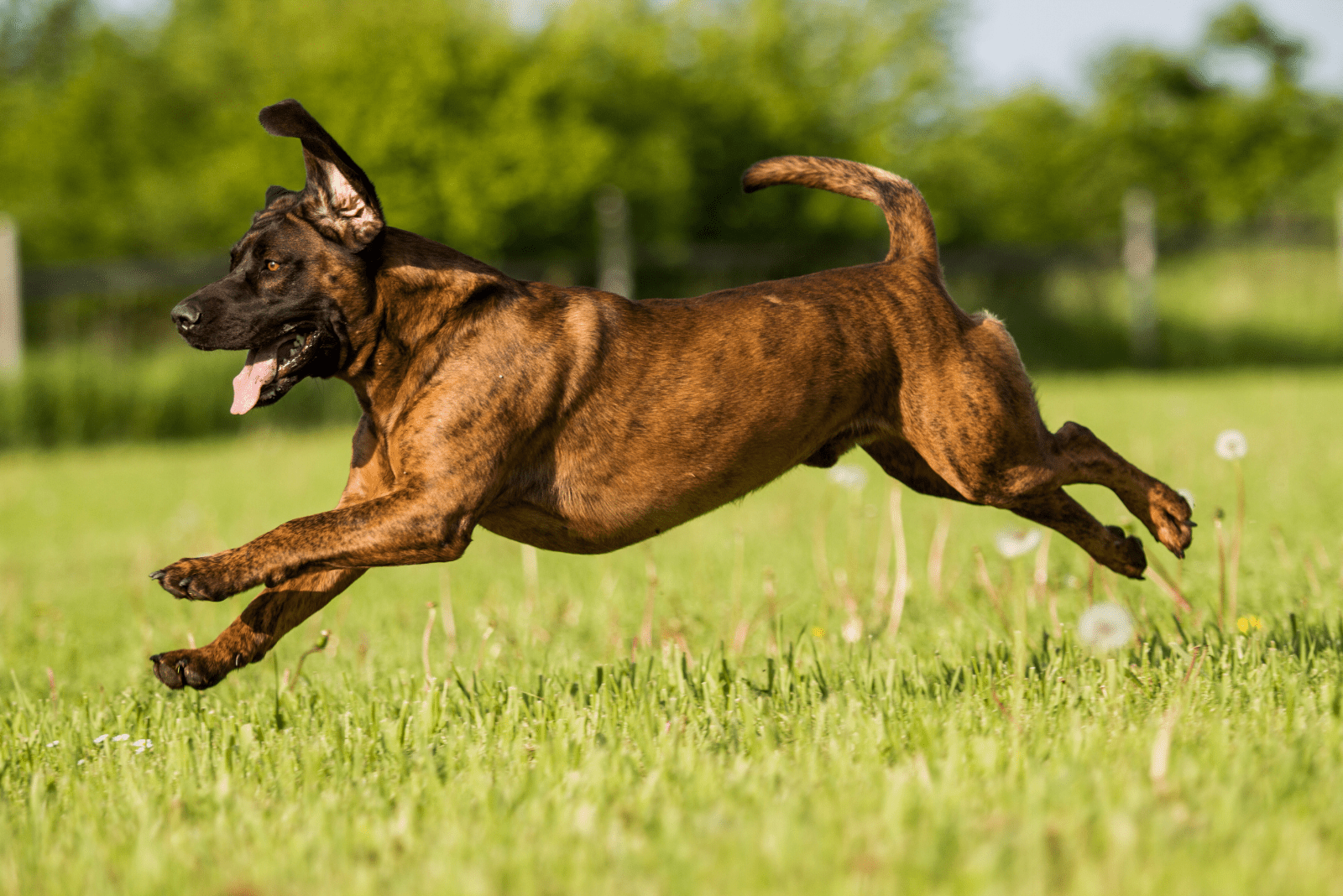
Similar to Bloodhounds, Beagles, and European and American Basset Hounds, the Hanoverian Scenthound is a remarkable pooch with a sharp nose. However, a Hanover Hound’s appearance is much different from the rest.
History
Like most hunting dogs, the Hanoverian Scenthound descends from bloodhounds that were used to sniff their way to their prey!
This is one of the oldest hunting dog breeds — dating back to the 1600s. The Hanoverian Scenthound was discovered in the Kingdom of Hannover, which stands behind its further development.
Appearance
With a sturdy and muscular posture, the Hanoverian Scenthound proudly stands 20 inches tall. One of the most distinguished physical characteristics of the Hanoverian Scenthound is its big, floppy ears.
Though, due to their floppy ears that fold downwards, Hanoverian Scenthounds are prone to ear infections.
The Hanoverian Scenthound is a short-haired, medium-sized pooch with wonderful coat colors that range from brindle to red.
Temperament
As an agile hunter, an incredible tracker, and an energy-packed canine, the Hanoverian Scenthound is a great choice for active owners.
The Hanoverian Scenthound loves to be out in the wild, and it might get carried away if it senses an interesting smell. This can also lead to it escaping and jumping fences.
35. Keeshond
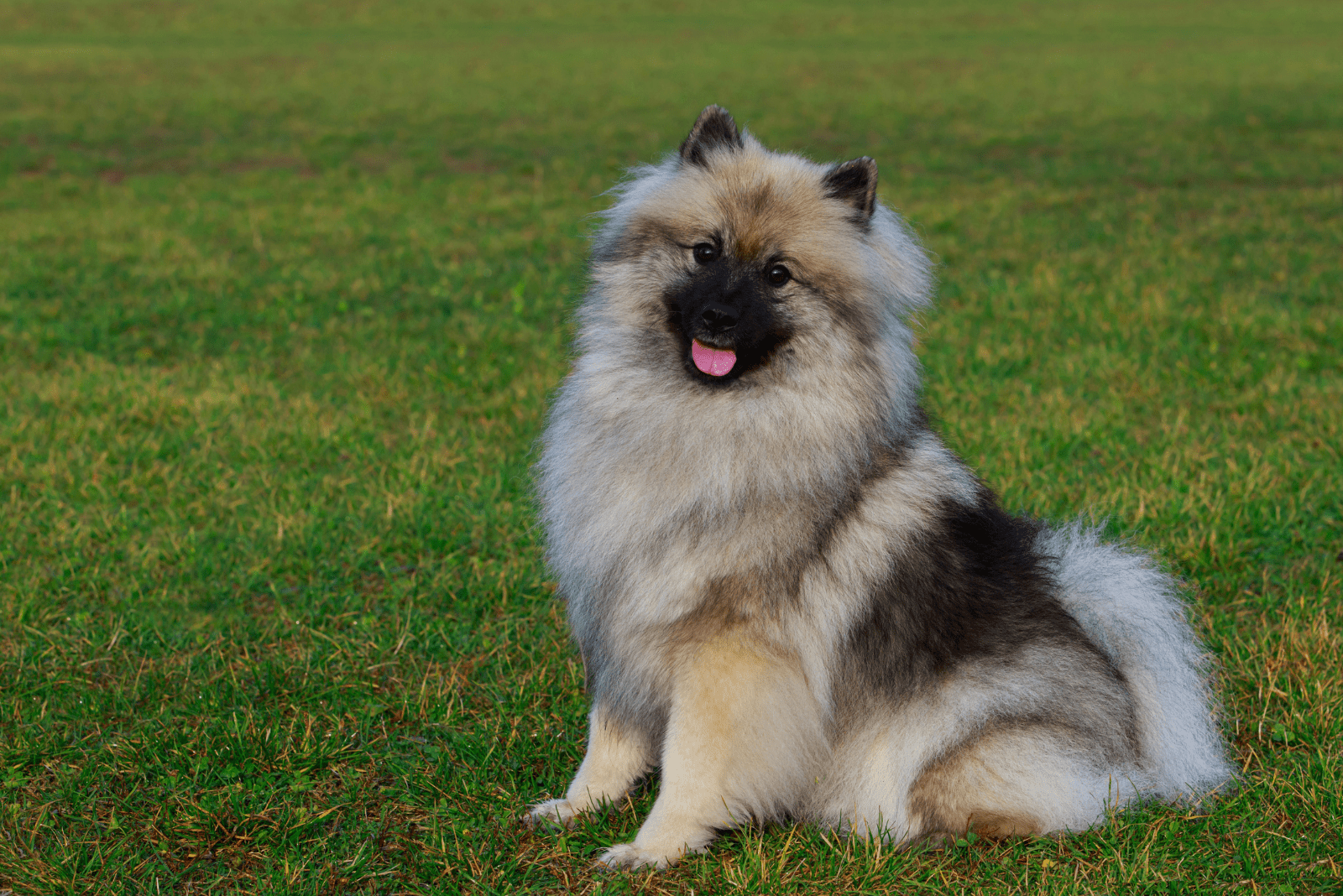
Take a look at this Wolf-Spitz kind of dog. The fluffy, four-legged creature we know as the Keeshond is guaranteed to steal your heart!
History
With a rebellious history, the Keeshond pup became very popular during the 18th century. It was developed in the midst of rebellion against the House of Orange.
The creator behind this fluffy breed was Cornelis (Kees) de Gyselaer (hence, the name Kees-hond), a Dutch patriot involved in the above-mentioned rebellion.
It is said that the Keeshond dog breed was developed from pups that were imported from both Germany and the Netherlands. This is why the Keeshond is half German, half Dutch!
Appearance
The Keeshond is a compact, medium-sized, fluffy dog that inherits the cutest ears! Its soft ears are pointed upwards, and they move according to its mood.
Another remarkable trait is the Keeshond’s rich tail that is covered in dense, fluffy fur.
In the American Kennel Club (AKC) Keeshond breed standard, this Spitz-type dog grows up to no more than 18 inches tall, and weighs up to 40 pounds (FCI breed standards).
Temperament
Did you know that the Keeshond is one of the smartest dog breeds? Well, now you know! In fact, the Keeshond is so intelligent that it might unintentionally pick up its owner’s behavior!
Besides that, the Keeshond is very alert around strangers, and it is ready to protect its family.
36. Pudelpointer
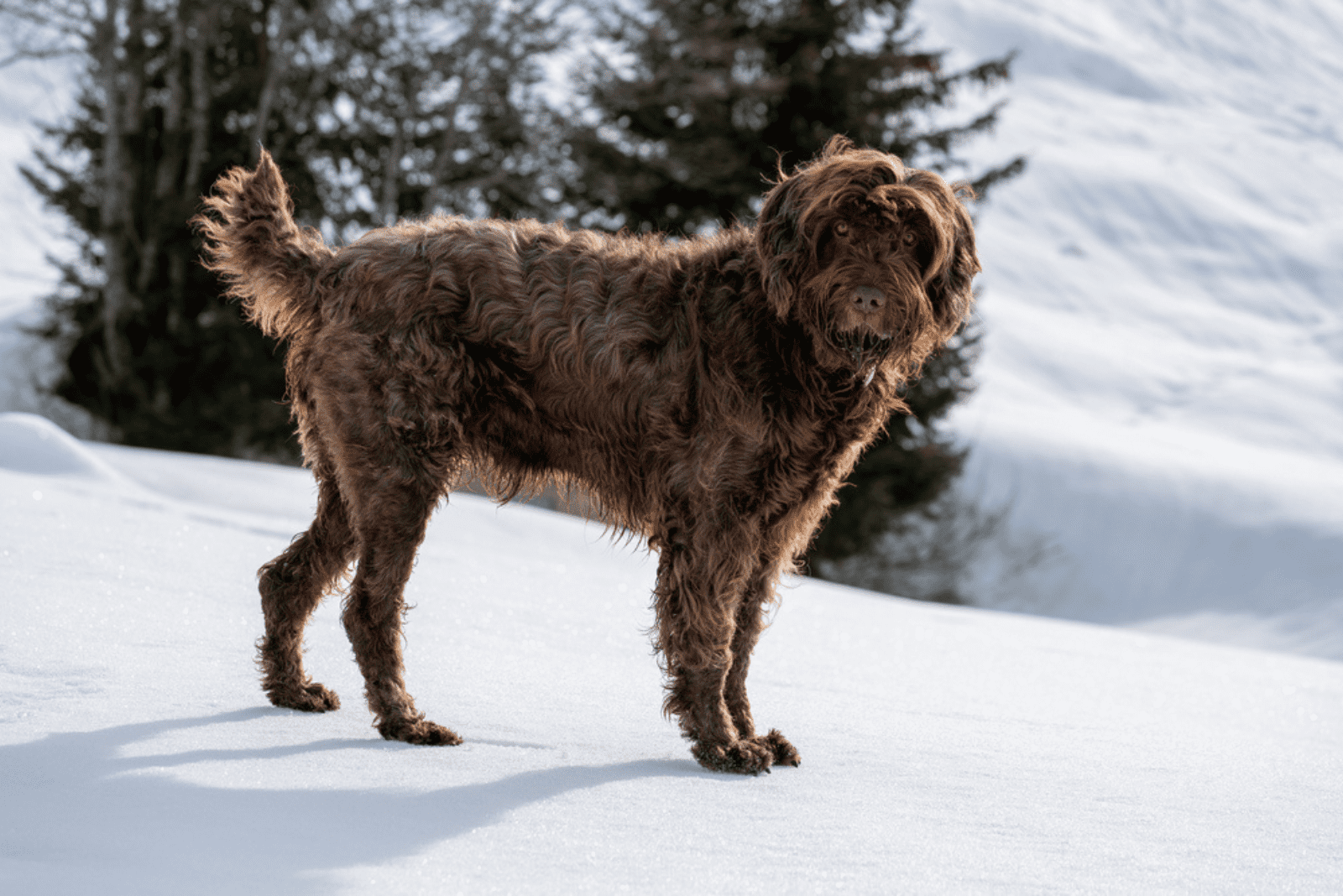
Derived from over seven types of Poodles, and more than hundred different pointing dogs, the Pudelpointer took some time to develop!
History
It all started back in 1881 when a German dog breeder established a top breeding program that resulted in creating the perfect gun dog.
The Pudelpointer became Germany’s favorite gun dog, with the characteristics of a tracker, pointer, and vigilant hunter.
Appearance
Usually brown in color, the Pudelpointer is a medium to large dog that grows up to 26 inches in height.
A remarkable appearance trait that makes the Pudelpointer stand out among other pointers is its wirehaired mustache that spreads alongside its muzzle, towards its forehead.
Find Your Pudelpointer: 10 Best Pudelpointer Breeders In The United States
Temperament
Sometimes laid-back, sometimes very energetic and active – the Pudelpointer inherits a well-balanced personality.
Its high prey drive may lead it to chase smaller animals, so it’s important to make the Pudelpointer go through early socialization.
37. German Spaniel
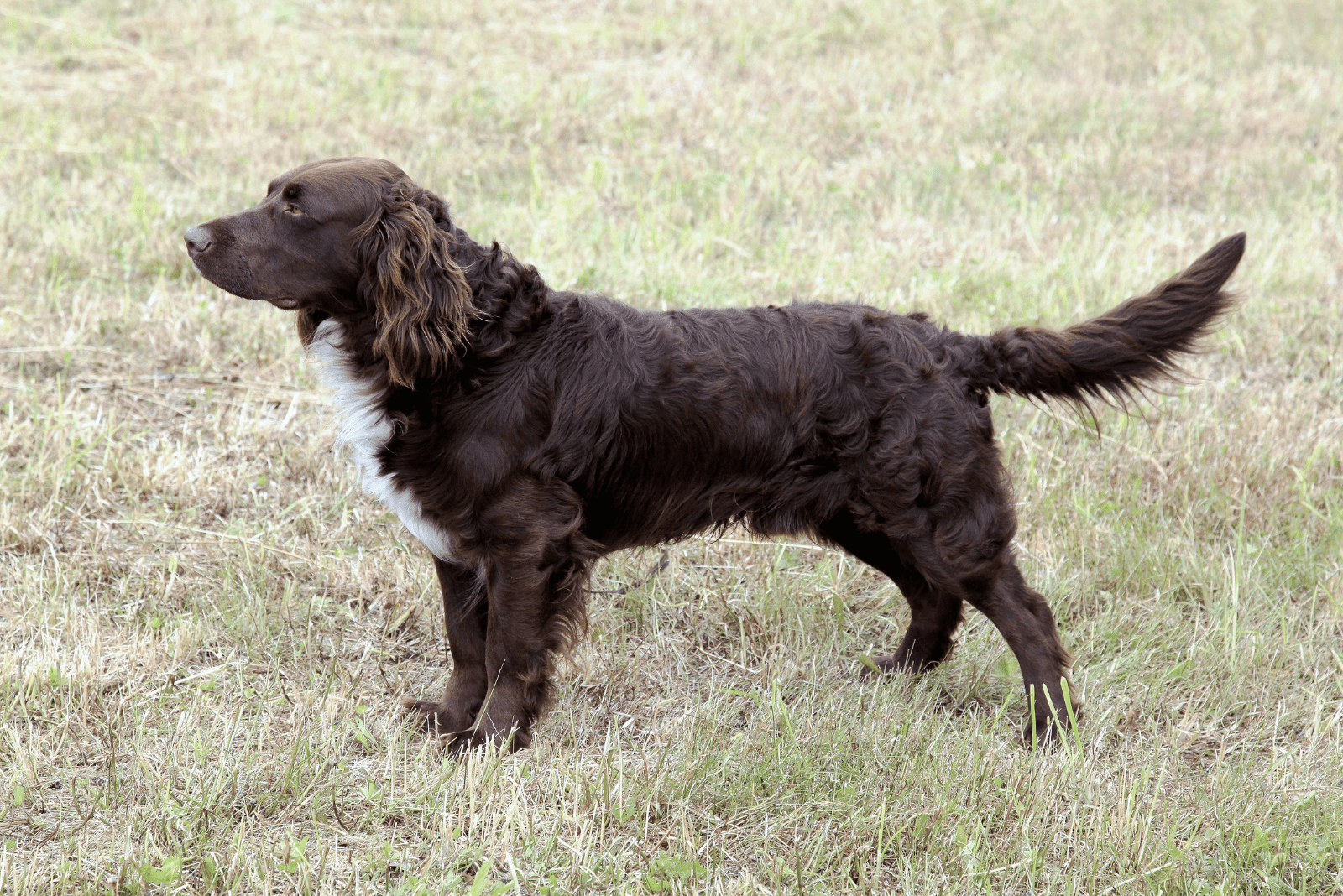
The German Spaniel is known for its shiny brown coat and floppy ears. It’s one of those dogs that is impossible not to notice!
History
The development of the German Spaniel dog breed was completed back in the 19th century.
Dog breeders decided to mix and match sporting Spaniels with different water dogs.
Appearance
The German Spaniel resembles pretty much both the English and the American Cocker Spaniel. Its medium-long, wavy coat is usually colored in shades of brown.
However, the German Spaniel’s coat can also be colored in a roan color pattern. Although it might appear big, the German Spaniel is a medium-sized dog breed.
Temperament
They are loyal, spunky, and sometimes sassy, but overall adventurous and cuddly. The German Spaniel will do everything to make its owner laugh, but it also likes to get its own way.
38. German Wirehaired Pointer

Check out the German Wirehaired Pointer — an active pooch with lots of love for the outdoors. Grab your frisbee… it’s time to go out to the dog park!
History
Discovered in the 19th century, the German Wirehaired Pointer quickly became the top hunting dog in Germany.
It took Pudelpointers, Polish Water Dogs, Stichelhaar Dogs, Griffon-type dogs, and German Shorthaired Pointers to create the German Wirehaired Pointer
Appearance
German Wirehaired Pointers look a lot like German Shorthaired Pointers, but with a wiry, roan coat. Inheriting a large and sturdy body, the German Wirehaired Pointer performs very well on ruff terrain!
Their muzzle is covered with a fancy, light to dark brown-colored mustache that gives the German Wirehaired Pointer its unique looks.
Temperament
It’s safe to say that German Wirehaired Pointers are people’s best friends. They want to make their owner happy, and they will do anything it takes to make everyone around them smile.
39. Weimaraner
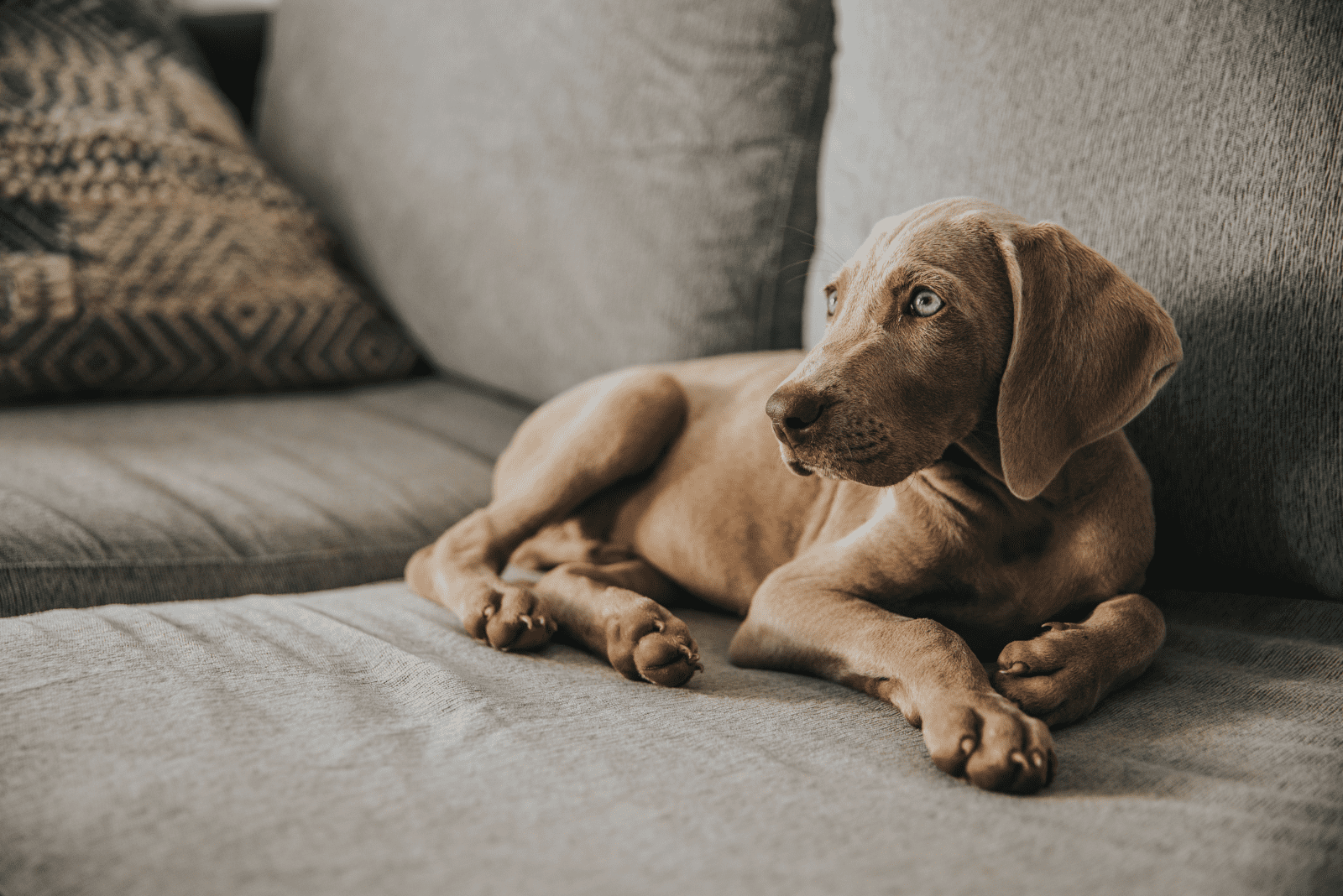
Here comes the Gray Ghost! Meet the Weimaraner – a hunting dog that you have probably already heard of. Here’s some brief info!
History
Bred to hunt wild boar, the Weimaraner kept company with German hunters back in the 1800s.
Supposedly, the Weimaraner was developed by mixing large dog breeds, such as the English Pointer, and the Great Dane.
Appearance
Weimaraners are gray. But, their coat colors range from many shades of gray. Although their coat is short, Weimaraners shed quite a lot.
Both male and female Weimaraners inherit a sturdy, but sleek body. However, male Weimaraners are larger, reaching up to 27 inches at the withers.
Temperament
If there is only one word to describe a Weimaraner’s temperament, then it would be loving. This dog is all about cuddles and playtime.
Even though the Weimaraner is an easy-going dog, it’s still important to socialize and train it as soon as possible.
40. Harlequin Pinscher
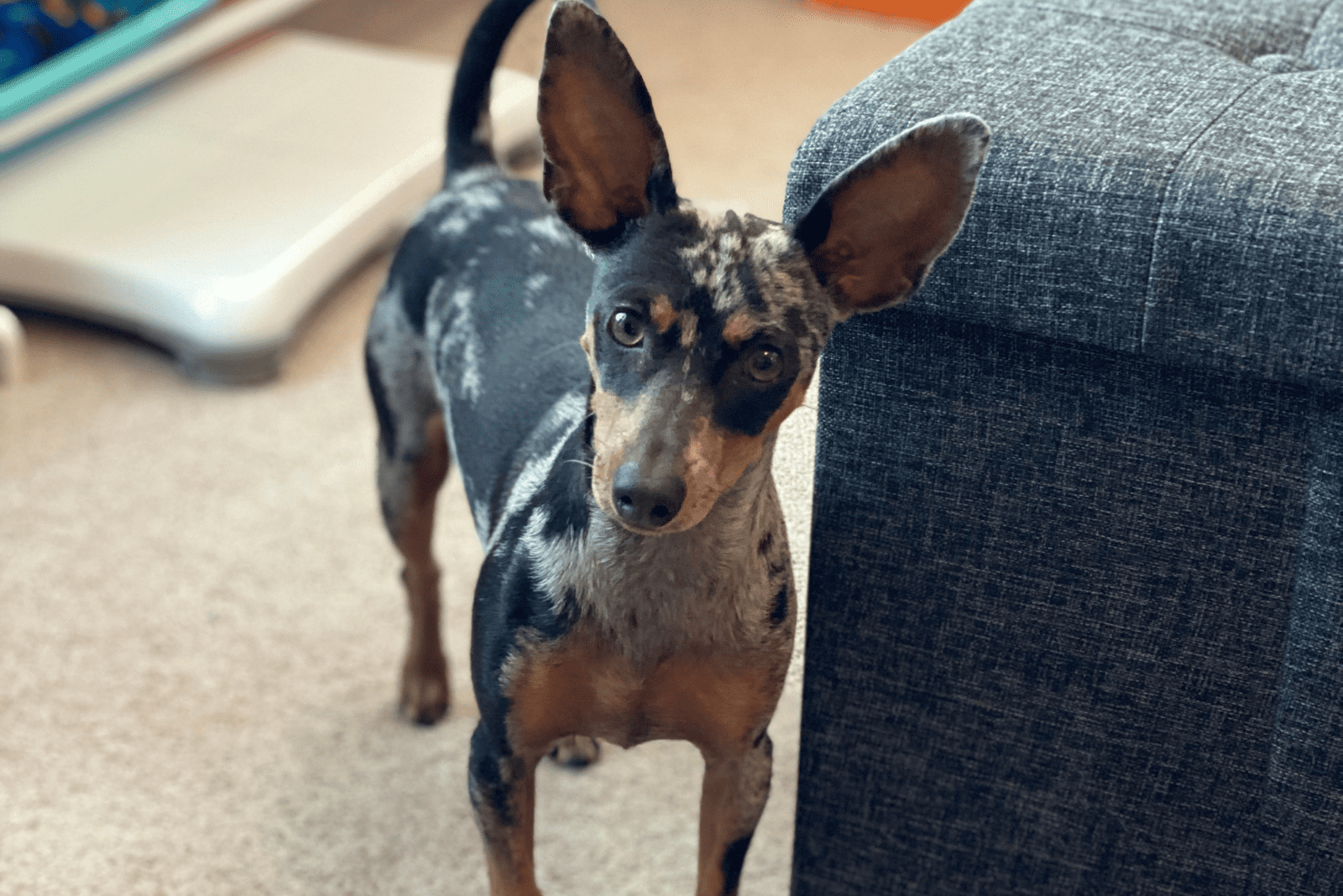
Meet a harlequin German dog breed that is very similar to the Miniature Pinscher. But, this is a completely different breed.
History
Dating back to the late 1800s when the Miniature Pinscher was all what the hype was about, the Merle Pinscher suddenly appeared and stole the show.
It is believed that Harlequin Pinschers derive from crossing only Merle Pinscher parents.
Appearance
A small dog with a short, harlequin coat and pointy ears — the Harlequin Pinscher is a very unique dog breed. It somehow resembles a Doberman Pinscher, but in a really small size.
The Harlequin Pinscher’s body is covered in shades of black, gray, tan, and white. Its whole body is spotted, which makes it look really cool!
Temperament
Harlequin Pinschers are extremely trainable. Sometimes, it seems as if they can understand every word you say! That being said, Harlequin Pinscher puppies need a lot of attention!
Outgoing and alert, Harlequin Pinschers are going to bark to inform their owner about every little thing!
Conclusion
Whether you are looking for a family dog, a working dog, a watchdog, or a guard dog, I am sure that you will find all of those in a well-rounded German dog breed.
Besides incredible personalities, German breeds are some of the most beautiful dogs that you will ever see! No wonder why they are becoming more popular with each passing day.
We are happy that such wonderful dogs have made their way to the United States, and that they continue to make our lives whole!
Hopefully, you have learned a lot about all the beautiful German dog breeds that we have put together for you.
Auf Wiedersehen!
Related Content
• The Best Doodle Breeds for Every Kind of Owner
• Guide To 28 Terrier Dog Breeds: Small, Medium, And Large Terriers
• Teacup Dog Breeds: Tiny Dogs With Big Hearts

